































LET GO AND FEEL


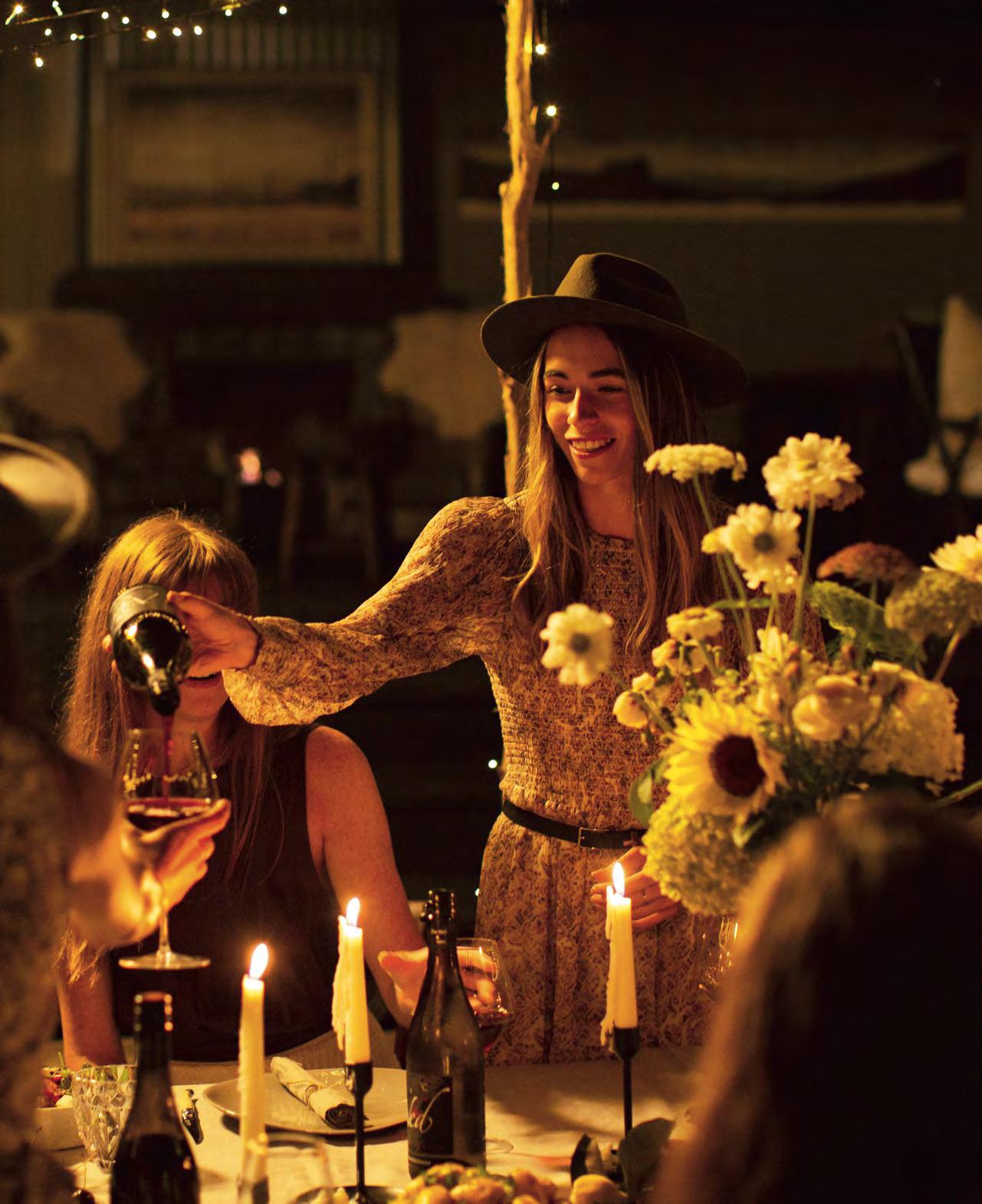
CONTRIBUTORS
Martin Gillion, Daniel Honan, Anne-Marie Nansett, Louis Pierard, John Saker, Charmian Smith, Vic Williams.
PHOTOGRAPHY
Courtesy of Winenz.com
Richard Brimer
DESIGN
Spinc Media
PUBLISHERS
Colin Gestro 027 256 8014 colin@affinityads.com
Joan Gestro joanlucy47@gmail.com
ADVERTISING ENQUIRIES
Jax Hancock 06 839 1705
jax.affinityads@gmail.com
WEBSITE www.winenzmagazine.co.nz
SUBSCRIPTIONS i-subscribe.co.nz
Or via 280 retail outlets including all Supermarkets.
Now celebrating over 30,000 readers per issue.
PUBLISHER www.affinityads.com
Publishers of: Active Seniors, Superbrands, Dive NZ, Select, Seniors and Travel Expo. PO Box 13257 Tauranga 3141
COVER PHOTO: By Čuvar Winery
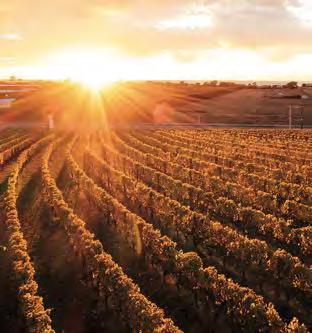

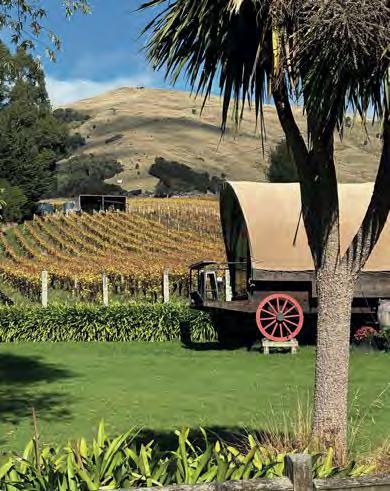
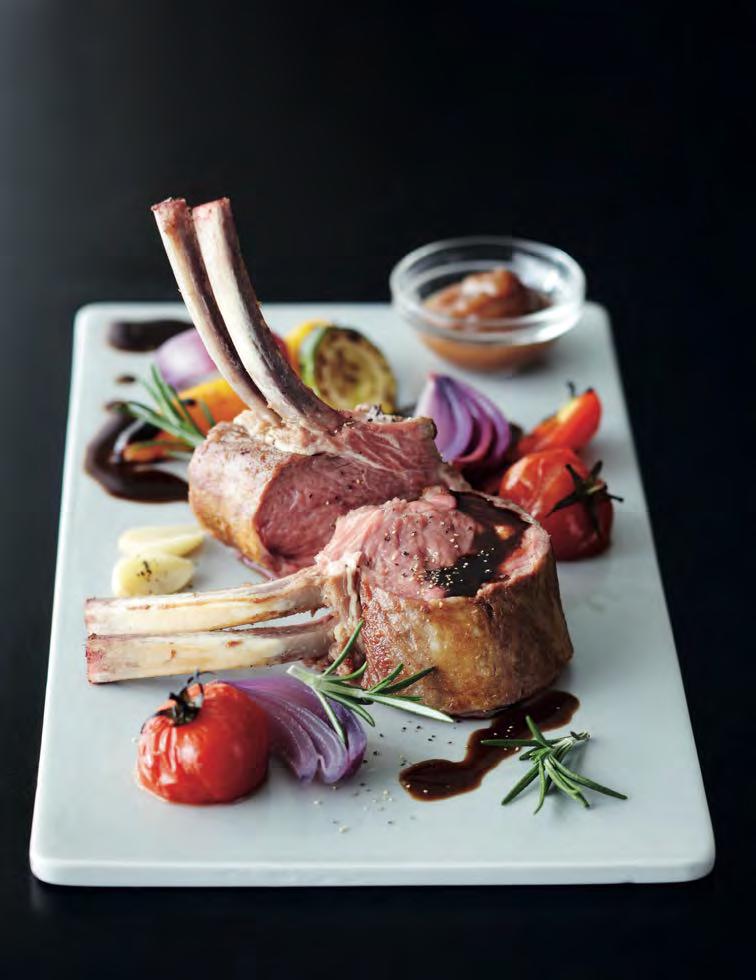


21 6 Sir George Fistonich,Villa Maria founder starts a new Family winery. And launces two great new brands.
10 French Peak,a Banks Peninsula winery that is scoring very high. Simon and Cardyn Lints are showing the way.
12 Chef Mark Southon presents his winter recipes. Wineries show the perfect matching wine with each.
21 Salmon and wine matches. Perfect pairing.
27 Wine and Time offers whats new in the Wine world. Also calling for award entries.
36 Wineries out West. Charmian Smith checks them out and sees how they are reinventing themselves.
44 New travel features show Cruising and Whitsundays destination.

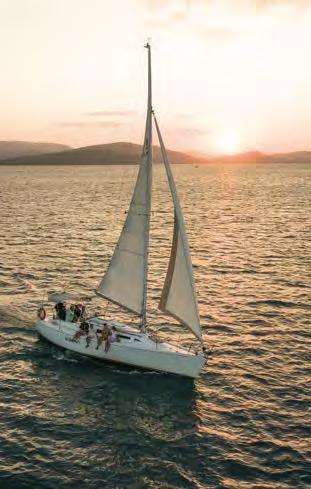
By Charmian Smith

SIR George Fistonich has a lifelong passion for wine, so perhaps it’s not surprising that, at 84, he’s started a whole new venture establishing Fistonich Family Vineyards and two new wine brands, his flag ship brand, Čuvar Winery and Obliix. Demonstrating his remarkable ability to rise like a phoenix from the ashes, Sir George, who was awarded a knighthood for services to wine and hospitality in 2009, is reinventing himself for the second time. Of Croatian descent, he founded Villa Maria in the 1960s when he was in his early 20s, building it up from a backyard operation to a major player. Then in 1986, he managed to trade his way out of financial difficulties with the help of a foresighted receiver and grew the company, buying other wineries: Esk Valley, Vidals, Thornbury, Leftfield, and Te Awa.
The Villa Maria group prided itself on being the country’s “most awarded winery” with a reputation for excellence and innovation and became a significant force in New Zealand wine. However, in 2021 disaster hit again - Covid, bad weather, and low crops - but this time there was no sympathetic receiver. Instead, Villa Maria was sold to New Zealand winemakers Indevin. He was reported to be gutted, it was no secret he wished to retain control of the business.
But Sir George’s passion for wine obviously can’t be quashed. He bought back the old Esk Valley Winery and vineyards where he had planted the region’s iconic Terraces vineyard back in 1986, and vineyards in Gimblett Gravels and Marlborough’s Awatere Valley, and started making wine again.
“Significant change takes vision, nerves of steel, and a fierce belief in yourself and your team,” Sir George has said.
He sought former Villa Maria employees, notably Chief winemaker Michelle Richardson, winemaker of the year numerous times in the 1990s when she was chief winemaker at Villa Maria.
Ali Sundstrum, Premium Wine Marketing Consultant, also joined, who formerly worked for Sir George. Michelle and Ali worked closely with George to develop the concept of Čuvar, acknowledging Sir George and the many other Croatian families who have helped write the New Zealand wine story. Ali and Michelle brought on board the talented Helen Milner who brought the brand to life creatively through her use of storytelling and symbolism.

“The brand story around Čuvar felt so right for Sir George and his legacy, to celebrate the work that he has done for the New Zealand wine industry, along with his Croatian roots and the huge contribution many Croatian families have given to the New Zealand wine industry. Čuvar means Guardian in Croatian, a beautiful word and so symbolic,” Ali said.
Many former Villa employees were keen to work with Sir George again.
Part of Sir George’s vision has always included hospitality - he opened the country’s first winery restaurant at Vidals in 1979, where it continued to be the only winery restaurant in New Zealand for the next 5 years. Now he has plans to open a cellar door and tasting room in Bayview. The site has one of most spectacular views in Hawkes
Bay with rows of vines spreading down towards the Pacific.
Čuvar (pronounced Chu-var), which means “guardian” in Sir George's native Croatian, is his flagship brand featuring an iris logo, Croatia’s national flower, and a symbol of Čuvar’s founding ethos, hope, wisdom, trust, and valour. Besides the Iris Collection, there is also the Guardians Collection of super-premium wines made in the best vintages.
The secondary brand, Obliixthe name is a play on “oblique,” is a separate brand, made to have shelf impact and appeal in retail. The idea is diverging from the straight and narrow, designed to be different. Winemaker Michelle, comments “I follow no recipes or rules for these wines, I simply blend wines I know will be delicious and joyful.”

Sir George and winemaker Michelle Richardson.
The company is in its early stages and is still tweaking its offerings, but I was impressed by the selection of their fresh, approachable wines.
Čuvar Iris Sauvignon Blanc 2023 ($25) is more expressive, intense with lively hints of lime and a lovely texture.
Čuvar Iris Rosé 2023 ($25) is floral, just off-dry, with hints of strawberries but quite savoury flavours. It’s 80% pinot noir and 20% syrah. Ideal for summer and autumn drinking.
Čuvar Iris Hawkes Bay Chardonnay 2022 ($30) is from the lower block on the Terraces vineyard. It’s elegant, hinting of dusty pencil shavings, creamy and slightly nutty with a lingering finish.
The reds are designed to be accessible and there are several different blends, according to Kieran, from entry point Obliix, to mid-tier Čuvar Iris, and luxury Čuvar Guardian.
Čuvar Iris Merlot Cabernet Franc 2022 ($30) oozes sweet fruit, plums, hints of dark chocolate, warm spice, and firm plush tannins.
Čuvar Iris Malbec Merlot 2022 ($30) is a stylish wine, aromatic and intense, with ripe fruit, charming, textural, and complex with firm, nicely balanced tannins. Lovely now but good drinking over the next two or three years.
Obliix Marlborough Sauvignon Blanc 2023 ($24) is a classic Marlborough savvy, fragrant, simple with a hint of mineral, clean and very crisp.
Obliix Syrah 2022 ($24) also includes 12% malbec and 8% viognier. It’s a lighter style of red, easy drinking and fragrant with suggestions of cherries and red fruit and soft but spicy tannins. cuvarwinery.com @cuvarwinery


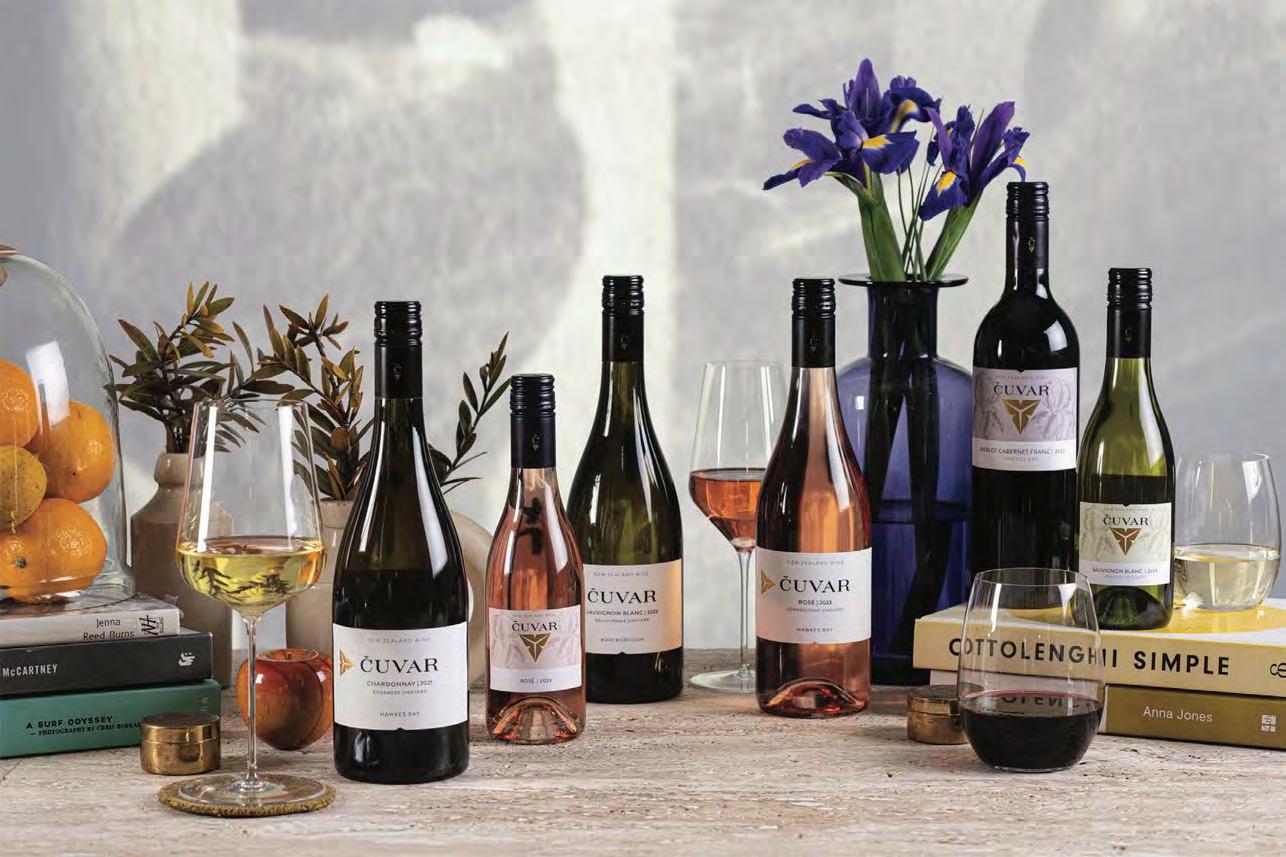





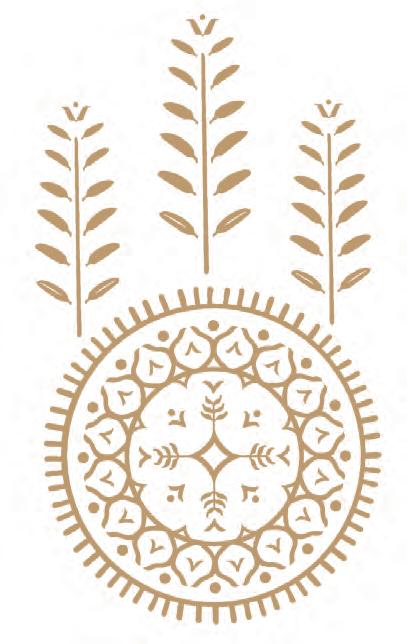

By Gillian Vine
WHEN Simon and Carolyn Lints decided to submit six of their 2023
French Peak wines for review, they were confident about the quality but it was more about assessment than expecting the high ratings they scored.
April’s Orbit results sees the Banks Peninsula winery putting five-star gold stickers on five wines and a 4.5-star label on its rosé.
French Peak’s top-ranked Kumara's Reserve Pinot Noir 2023 and chardonnay scored 94 out of a possible 100 points; pinot gris, pinot noir and sauvignon blanc rated 93; and the rosé 91.
It was an exceptional result, a delighted Simon Lints said.
The news got better: all four French Peak entries in this year’s NZ Organic Wine Awards were medal winners, the chardonnay and rosé taking home silver, while the pinot noir and pinot gris won bronze.
“We are thrilled,” Simon said.
The Lints, originally from Scotland, bought French Peak unseen in 2020, while they were in Covid-19 lockdown in Singapore, where they were working, Carolyn in law and Simon in banking.
The 4.5ha estate has 3ha in vines. When the Lints took over in May 2022, the vines were unpruned and the first season yielded just one tonne of fruit.
In each of the two following years, the harvest was seven tonnes, an indication that French Peak had the potential to become the sustainable business envisaged by its owners.
“In the future, we’d very much like to try other interesting varieties,” Simon said.
“Gewürztraminer is one worthy of consideration [because] we bought some in under our label and it was so successful, it sold out.”
French Peak is part of an area cleared in the 1840s and farmed by French migrants. One of the oldest houses in New Zealand, French Farm House, sits in a paddock just below the Lints’ property.



“We believe some of our vines are derived from the original plantings of French settlers,” Simon said.
With the assistance of Lincoln University, DNA testing will determine if this is correct.
“It would be fantastic if it were true.”
Cellar-door sales are booming. Prices range from $40 for rosé to $50 for chardonnay and 99% of visitors buy wine.
Simon and Carolyn are strong supporters of the wine industry’s move to follow Australia and permit wineries to charge for cellardoor tastings.
“For smaller players, it would make a difference to cashflow,” Simon said.
The couple is not relying solely on their award-winning wines. The French Peak Wagon is set up
for romantic getaways and there are plans are to further develop accommodation on the property.
High-end weddings with 50-60 guests are another option, while French Peak’s attractive gardens are drawing visitors, too, and in November will be part of the biennial Inside Out tour.
“We’re very flattered to be asked to take part in that,” Simon said.
With initiatives such as these and multiple awards, French Peak’s original settlers must be looking down and raising their classes to the Lints.
TO GET TO FRENCH PEAK, right at Barry's Bay into Wainui Main Road. Some 3km from the turn off, turn right into French Farm Valley Road and the winery in on the left above French Farm House.


Readily available from most good butchers, this inexpensive cut of beef can be transformed with just a little love and time into a superb melt-in-the-mouth dish. I like to give a crispy contrast to the dish by adding some buttered brioche croutons at the end
4 beef cheeks, trimmed vegetable oil
1 cup roughly chopped carrot
1 cup each: chopped onion, leeks and celery
2 cloves garlic
2 sprigs of thyme
150ml red wine
500ml beef stock
salt and pepper
fresh thyme sprigs
Roast Baby Onions, halved
Vanilla Carrot Purée
3 carrots, chopped
50g butter
seeds from 1⁄2 vanilla pod
salt and pepper
Thyme Glazed Carrots
30g butter
16 baby carrots
1 teaspoon thyme leaves
Brioche Croutons
25g butter
100g brioche, cubed
MATCHED WITH
Heat a large frypan until hot, then seal the beef cheeks in a little oil on all sides until well coloured. Remove from the pan and set aside. Reduce the heat and add the vegetables, garlic and thyme to the pan. Cook for 10 minutes, then add the wine and boil for 2 minutes. Add the stock and simmer for 30 minutes.
Return the cheeks to the pan and bring back to the boil. Cover and reduce the heat, cooking slowly for around 3 hours until the cheeks are tender. Remove the cheeks and set aside until required. Strain the liquid back into the pan and boil to reduce by half.
To make the purée, fry the carrots in the butter in a saucepan over a medium heat for about 10 minutes, stirring frequently. Add the vanilla seeds, season to taste, then add just enough water to cover the carrots. Boil rapidly until soft, adding more water if needed. Transfer the cooked carrots to a food processor and blend with enough of the pan liquid to make a smooth purée. Peel and trim the baby carrots. Heat the butter in a frypan until foaming and sauté the carrots until lightly coloured but still crunchy. Stir through the thyme leaves, then set aside to keep warm.
Use the same frypan to make the brioche croutons. Heat the butter until a light nutty brown colour, then stir through the brioche cubes until toasted. Season and drain.
Gently reheat the beef cheeks in the sauce until warm and glazed. Spoon some carrot purée onto each plate and top with a glazed beef cheek. Scatter some brioche croutons and roasted carrots around the plate, then garnish with fresh thyme sprigs and roasted baby onions.
GIMBLET GRAVELS
MALBEC 2019
Intense and powerful with aromas and flavours of violets,dark chocolate and treacle.
Mouth filling texture with fine structural tannins.
I source most of my lamb for the restaurants from Bill of Leelands. This South Island farmer is located just outside of Invercargill. The lambs are grown on lush southland pastures with sustainability in mind. The meat is tender and the flavour profile is sweet and deeply rich. The taste of lamb varies depending on geographic location, breed and grazing conditions – all factors dramatically affecting the flavour, texture and fat content. For this recipe, I use Hawke’s Bay lamb racks. You’ll need to prepare the semi-dried tomatoes for this dish well ahead of time.

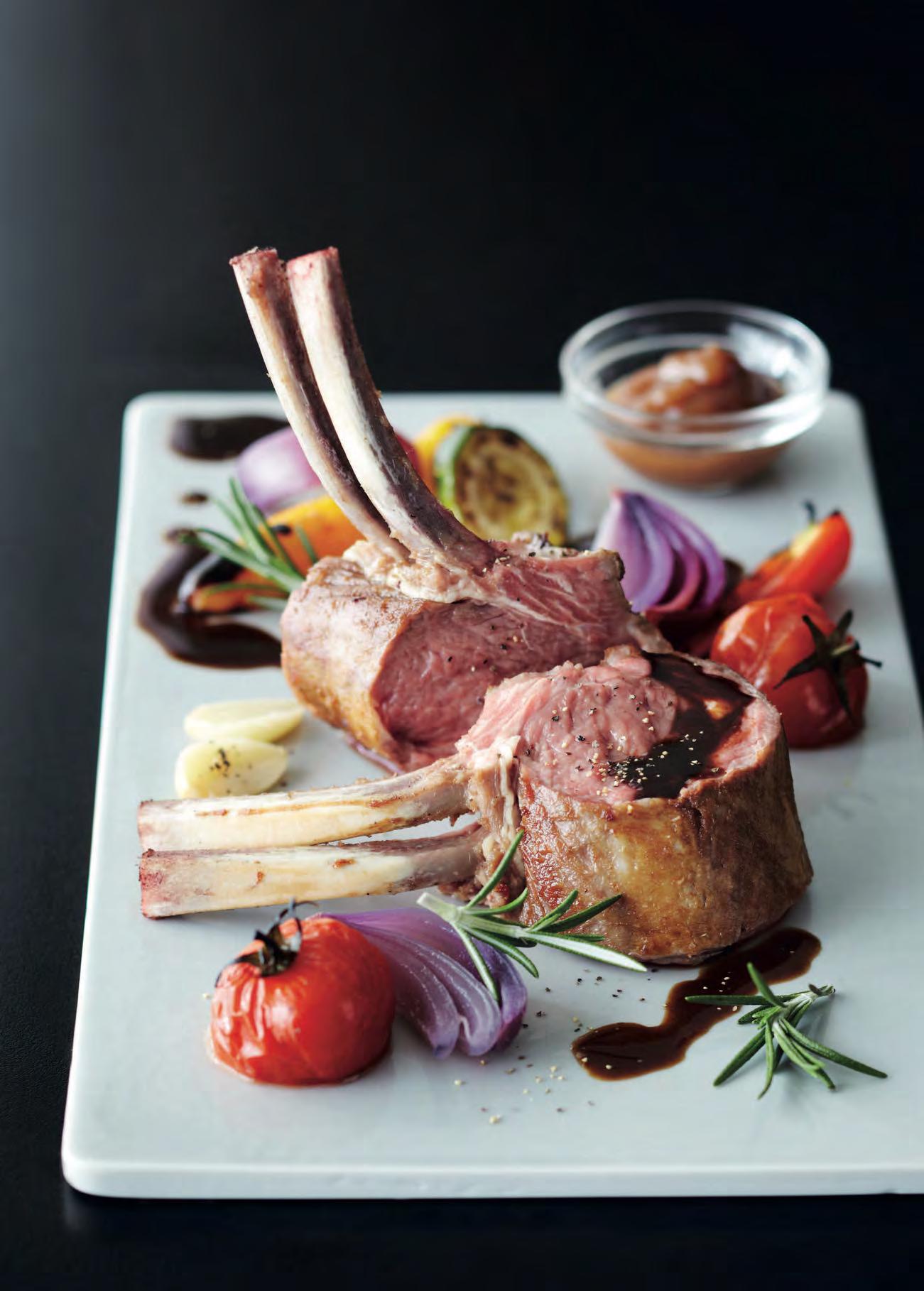

I source most of my lamb for the restaurants from Bill of Leelands. This South Island farmer is located just outside of Invercargill. The lambs are grown on lush southland pastures with sustainability in mind. The meat is tender and the flavour profile is sweet and deeply rich.
2 x 8-point racks, trimmed salt and pepper
Roast Vegetables
1 courgette
4 red and 4 yellow mini sweetie peppers
light olive oil
salt and pepper
8 cloves garlic, peeled
2–3 sprigs of thyme canola oil to cover
100ml Red Wine Jus sprigs of rosemary
Roast Red Onions
8 Semi-dried Tomatoes
Candied Eggplant
3 eggplants
100g sugar
1 onion, finely diced
2 cloves garlic, finely chopped
1 chilli, finely sliced, including seeds
juice of 2 limes
2 tablespoons chopped coriander
Preheat the oven to 200 ºC.
Season the lamb racks, then seal in a large, hot frypan for 3–4 minutes on each side until the fat starts to colour. Transfer to a baking dish and place in the oven for 12–15 minutes or until cooked to just under medium-rare (pink). Set aside to rest in a warm place.
To make the candied eggplant, prick them all over with a fork, then roast over an open gas flame for 3–5 minutes on each side until black and soft (or oven roast them at 250–300ºC until blackened). When cool enough to handle, cut each in half and scoop out the flesh. Place 1⁄2 cup of water and the sugar in a large saucepan and cook over a high heat until it turns a deep caramel colour, taking care not to burn it. Add the onion, garlic, chilli and lime juice and cook over a reduced heat for 10 minutes. Add the cooked eggplant flesh and cook for a further 10 minutes. Stir in the coriander and a pinch of salt and transfer to a food processor. Blend until smooth. Set aside to cool.
To make the roast vegetables, cut the courgette diagonally into 3mm-thick slices. Quickly pan-fry the slices in olive oil in a hot frypan until coloured but still crunchy. Cut the mini sweetie peppers in half lengthways and remove the seeds, then drizzle with a little olive oil.
Season and cook, ideally on a hot plate, until soft and charred. In a small saucepan submerge the garlic and thyme in oil and gently cook until soft, about 20–30 minutes. The oil should not boil and the garlic should stay white.
To complete the dish, warm the red wine jus with the rosemary for 10 minutes to infuse, then remove the sprig and discard.
MARLBOROUGH
SAVIGNON BLANC 2023
Classically Marlborough,our 2023 vintage shows ripe passionfruit,lime,and grapefruit notes.
Multi layered palate of citrus and some minerality make this wine rich and complex.
Carve the lamb and divide between warmed plates with the courgettes, peppers, onions, confit garlic and semi-dried tomatoes arranged around the meat. Spoon over the jus and serve some candied eggplant on the side garnished with fresh rosemary tips.
The finish is a full textured wine with balanced acidicy.

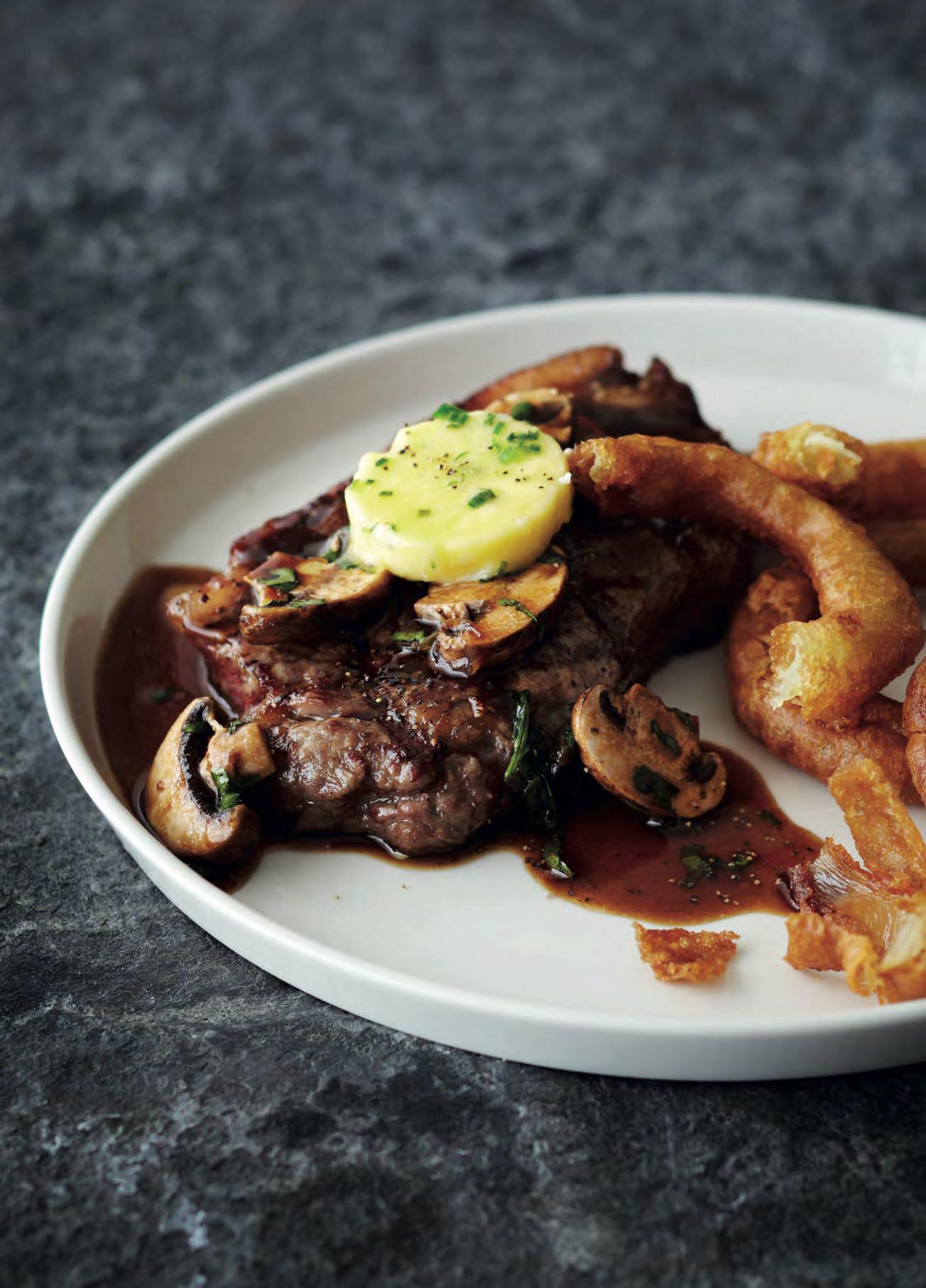
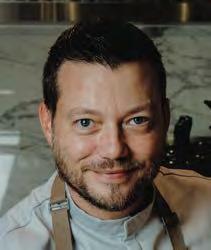
For this dish I use Wakanui sirloin from grass-fed Angus cattle that are finished on grain for their last 70–90 days, which results in a great flavour and fat marbling. Dry-ageing is a 4–5 week process used by good butchers to enhance the flavour profile, making the meat so tender that it melts in the mouth. The only snag is the loss of around 15–20% of the total weight, plus you then have to trim away all the dried black skin, but it’s worth it!
4 x 250g dry-aged sirloin steaks, trimmed
salt and pepper
Garlic Butter
Crispy Onion Rings
Mushroom Sauce
1⁄2 onion, thinly sliced
Oil
1 clove garlic, thinly sliced
10 button mushrooms, sliced
15ml Henderson’s or Worcestershire sauce
100ml Red Wine Jus
1 tablespoon cream




Preheat the oven to 200ºC.
Season the steaks, then place on a hot grill and cook for 2 minutes or until the underside is charred. Rotate each steak 45º and cook for a further 2 minutes to create a criss-cross marking. Repeat on the other side. Finish the steaks in the oven for 2–3 minutes for medium. Set them aside to rest in a warm place.
To make the sauce, sweat the onion and garlic in a little oil in a frypan until soft and lightly coloured. Add the mushrooms and sauté for 1 minute, then deglaze the pan with the Henderson’s or Worcestershire sauce. Add the jus and bring to the boil, then add the cream and gently simmer for 5 minutes. To serve, slice the steak across the grain and arrange on warmed plates. Spoon over the mushroom sauce and top each steak with a disc of garlic butter. Serve with Crispy Onion Rings.
Harvested from the very best fruit on the home estate.
The nose has bold aromas of wild roses,bluebury and spice.
The palate is packed with vibrant fruit,tannins and acidicy combined in a seamless finish.



I like to sous-vide or slow cook eye fillet in duck fat, garlic and thyme for 2 hours in a water bath, at 52°C, to get a melt-inthe-mouth piece of meat and a fantastic flavour. But at home you can cook it in a frypan to your liking. The bone marrow crust on this meltingly tender fillet gives the meat an extra depth of richness. And serving it with parsnip purée adds sweetness.
SERVES 4
4 x 200g eye fillet steaks
1 parsnip, peeled oil for deep-frying salt
Parsnip Purée
12 Roast Baby Carrots
4 Roast Baby Onions, halved small nasturtium leaves
100ml Red Wine Jus
Chef’s Tip
Bone Marrow Crust
120g brioche crumbs
50g butter
1 shallot, finely chopped
1 clove garlic, finely chopped
1 teaspoon finely chopped thyme leaves
80g bone marrow, chopped and chilled salt and pepper
To prepare the bone marrow, soak in cold water for 1-2 hours to extract any blood, then roast in a hot oven at 200oC for 6-8 minutes, cook slightly and pop the fat from the bone. Chill in the fridge until hard.
MATCHED WITH
Preheat the oven to 200oC.
To make the crust, toast the brioche crumbs in the oven until golden brown. In a saucepan sweat the shallot and garlic in 1 tablespoon of the butter until translucent but not browned. Add the thyme and transfer the mixture along with the brioche crumbs to a bowl. Stir through the bone marrow and the rest of the butter and season. Roll out the mixture between 2 sheets of greaseproof paper to about 3mm thick. Chill for at least 30 minutes.
To cook the meat, heat a little oil in a heavy-based frypan until hot and seal the steaks on all sides. Transfer the steaks to the oven and cook, turning regularly (6–7 minutes for medium-rare; 5–6 minutes for medium). Meanwhile, cut the chilled crust into 4 discs. Remove the fillets from the oven and place a disc of chilled crust on top of each. Brown under a hot grill for a couple of minutes, then set aside to rest in a warm place.
To finish the dish, peel the parsnip into thin ribbons. Heat a deep-fryer to 160oC and deep-fry the ribbons until golden brown and crisp. Drain on absorbent kitchen paper and sprinkle with a little salt.
To serve, slice each fillet in half through the crust to reveal the tender pink flesh and arrange 2 halves on each plate.
Perfumed aromas of ripe red cherry fruits, spice, licorice, and herbs. The palate is elegant and generous, with silky and succulent tannins. The wine shows great balance and persistence on the finish.
An intensely perfumed Syrah of individual style and character that deftly illustrates the beauty of the variety is famous for.

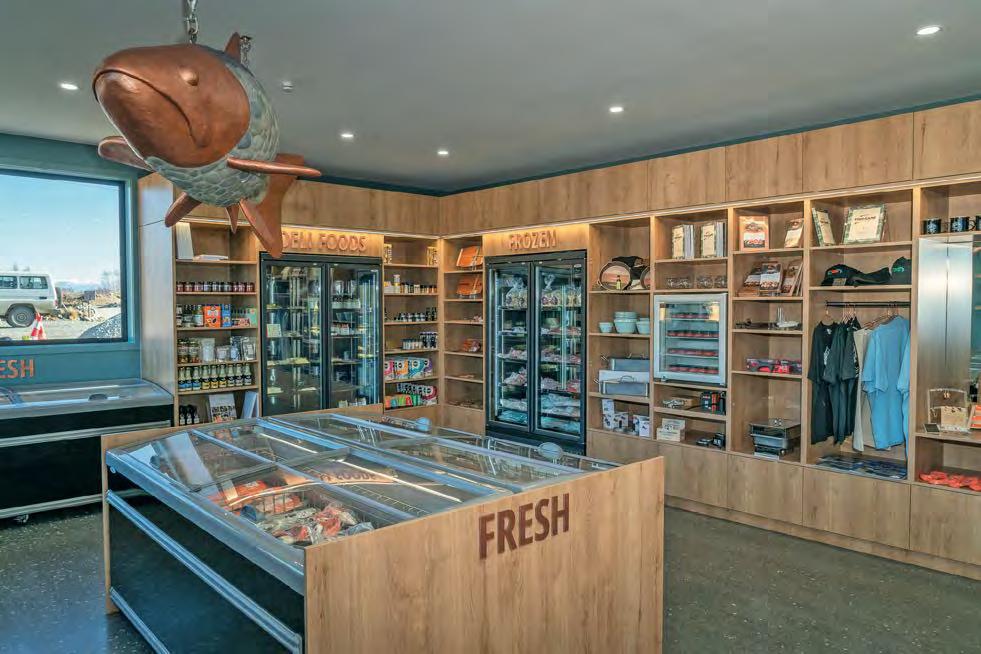
AMIDST the pristine landscape of New Zealand's Southern Alps, a culinary treasure thrives in the glacial waters of the Mackenzie Country hydro canals. High Country Salmon offers a taste of luxury that is not only unparalleled in flavour and texture but also a testament to their sustainable farming practices. As connoisseurs of fine food and wine, we understand the importance of the origin and cultivation of our ingredients, and High Country Salmon is delivering on quality and sustainability in the world of aquaculture.
These Chinook (or King) salmon are nurtured by the staff and the pure, fast-flowing waters that descend from the rivers and glaciers in the region. This unique environment
contributes to the development of a salmon that is fitter than seafarmed salmon, with a texture and flavour profile that is distinct to
New Zealand freshwater salmon. The cold, oxygen-rich waters allow these fish to grow at a natural pace, free from the stresses of


overcrowding, ensuring a firm flesh with an incredibly clean flavour and distinct mineral notes.
It was in the late 1990’s that freshwater salmon farming pioneer, Richard Logan, decided that the site at the junction of the Ohau B canal and Wairepo Arm was the perfect place to grow Chinook salmon. The first smolt arrived on the farm in December 2000, and Richard put all his efforts into raising the salmon, and his wife Margaret set up a floating shop. While the business has evolved to now include a licensed café, a specialty salmon store and a “CatchA-Fish” experience, there is still a noticeable family feel with loads of rustic charm.
At High Country Salmon, the philosophy of sustainability is at the core of every practice. The farm operates with a deep respect for the environment, ensuring that the canal bed remains as clean as it was when the hydro system was built. This commitment extends to every aspect of their operation, from the absence of hormones, chemicals, and antibiotics to the hands-on care given to each fish. It is this dedication that has seen the company win an Environmental & Sustainability Award, and has led them to invest into research and development to turn salmon waste into a plant fertilizer.
High Country Salmon is the smallest commercial salmon farm in New Zealand and is the only one that doesn’t export their salmon. Sales & Marketing Manager Tracey Gunn says it is an important company value that we provide New Zealanders and people visiting our country the opportunity to try the best salmon the country can provide. The farm’s location just off the main road, 3km south of Twizel, is perfectly situated to entice visitors in, and they also
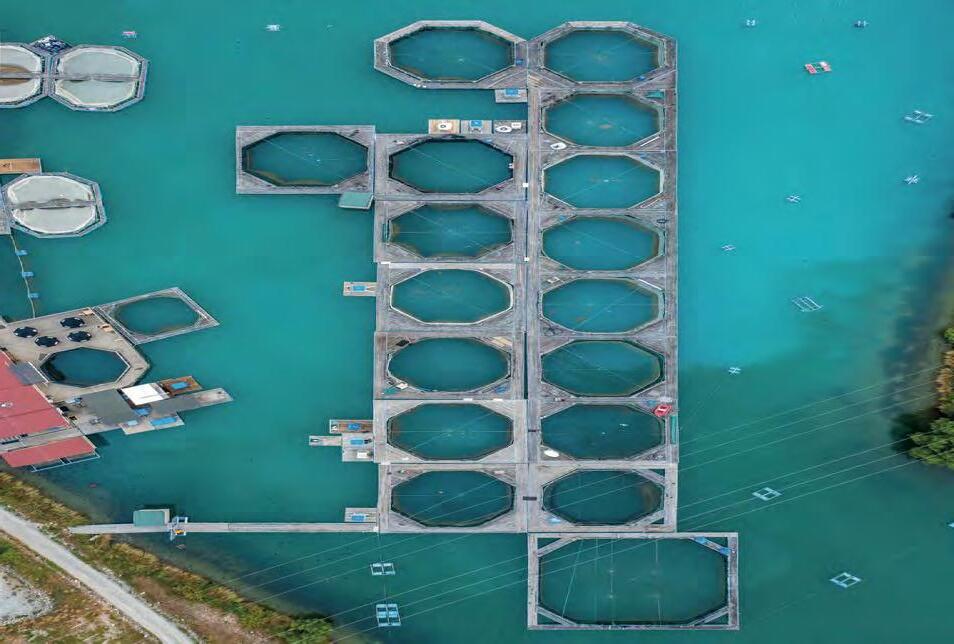

courier their “glacial mountain salmon” nationwide.
The difference in texture and flavour profile of High Country Salmon is not only a culinary delight but also a conversation starter about the importance of sustainability in our food sources. As we pair these delicate flavours
with our favourite wines, we also celebrate the efforts of those who work tirelessly to maintain the balance of our ecosystems. High Country Salmon is a great example of how quality and environmental stewardship can coexist harmoniously.
www.highcountrysalmon.co.nz

Ingredients:
4 x 180g High Country Salmon boneless portions, butterflied
½ fennel bulb
½ red onion
1 orange
8 T extra virgin olive oil
Zest and juice of 1 lemon
200g feta
¾ C Greek yoghurt
1 C mixed herbs (basil, parsley & mint)
Mint leaves & purple cress for garnish
Method:
1. Shave fennel and onion very thin with a mandoline. Peel and segment the orange, then place in a bowl with the fennel and onion. Add 2T of the olive oil and the juice of half the lemon. Season with salt and leave to marinate.
2. Blend feta, yoghurt and lemon zest in a food processor until smooth. With the motor running, drizzle in 2T of the olive oil. Refrigerate until ready to use.
3. Place the herbs, juice of the other half of the lemon, and remaining 4 T of olive oil into a blender. Blitz until the herbs are very finely chopped. Season and set aside.
4. Cook salmon in a frypan over a medium-high heat for 3-4 minutes each side, or until cooked to your liking.
5. Add mint leaves to salad, drizzle salmon with herb dressing, top with cress and serve with whipped feta.
SERVES 4

MATCHED WITH
Scents of white peach,ripe grapefruit, and citrus blossom combined with toasty, nutty oak aromas to produce a complex and engaging bouquet. The wine is rich and complex, yet remains focussed and composed with outstanding persistence and length of flavour.
A fine backbone of acidity combines effortlessly to produce a seamless. harmonious palate with a mouthwatering finish.





The freshest salmon - from glacier to plate!
Family-owned and nurtured with the pioneering spirit of salmon farming legend, Richard Logan, our salmon farm is a testament to his dedication and passion. Our sustainable practices ensure the health of our waters and the quality of our salmon.
Renowned for its firm texture and mild flavour, our glacial mountain salmon is the freshest you can get. Everything is done on-site, ensuring the shortest supply chain possible.




The online shop has the widest range of fresh, cured and smoked salmon to choose from, including lesser cuts like fins, and unique smoked & cured products. Delivery is overnight to non-rural addresses and the salmon is packaged with plenty of ice packs to ensure it arrives in the best condition.
Feed, catch & taste the salmon!
If you are in the Mackenzie Region, there is a range of things to do; have an amazing meal with a craft beer or local wine at Logans, feed the salmon (for free) on the floating deck, purchase some salmon to take home from the Fish Shop, or even catch your own salmon!
www.highcountrysalmon.co.nz Twizel, New Zealand

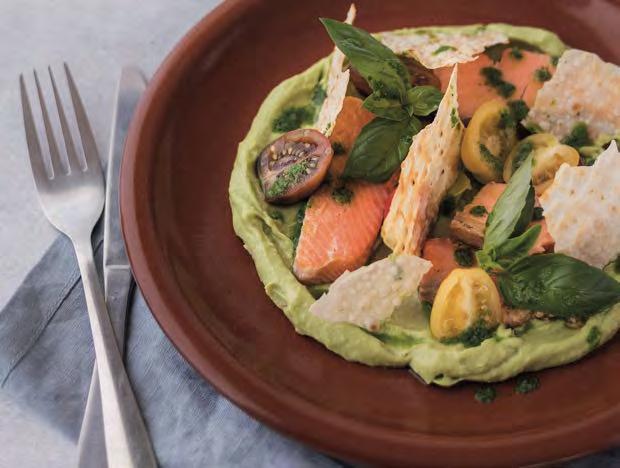

Ingredients:
300-350g Hot Smoked High Country Salmon
3 avocados
½ C sour cream
2 T lime juice
½ punnet mixed colour cherry tomatoes, halved Sardinian crispbread (or other thin, crisp bread)
1 C basil leaves, plus extra for garnish
½ C extra virgin olive oil
Method:
1. Place avocados, sour cream and lime juice in a food processor and blend until smooth. Season with salt and pepper and set aside.
2. Place basil in a heatproof bowl and pour over boiling water. Blanch for 15 seconds then fresh in a bowl of iced water. When cold, squeeze out the water and dry on paper towels. Place in a blender with the olive oil and season. Blend until the basil is very fine. Set aside.
3. Smear avocado cream over the bases of four serving plates. Flake the smoked salmon and arrange on the plates. Scatter over tomatoes and add broken crispbread pieces. Drizzle with basil oil and scatter over extra basil leaves.
SERVES 4
MATCHED WITH
Kidnapper's Chardonnay is shaped by its coastal proximity and clay soils, with a pale straw hue and a bouquet of oyster shells, sea spray, and cashews that evoke its seaside character. Crafted for balance, it offers intense citrus flavours and fresh mineral complexity with a subtle oak presence. On the palate, lively acidity and the taste of fresh lemon curd provide richness and vibrancy. Paired with salmon, its fresh citrus notes and acidity harmonise beautifully with the fish's delicate richness, enhancing the dish with its oceanic essence and nuanced flavours.

Falcon range cookers are the heart of the home. We look forward to showing you all the model options.
COME & SEE US IN OUR SHOWROOM - HASTINGS & QUEENSTOWN






WINE Marlborough General Manager Marcus Pickens describes why Marlborough Sauvignon Blanc has earned its place on the world stage.
“Marlborough-produced Sauvignon Blanc made a massive impact from the very first taste all those decades ago. It sort of shocked and surprised everyone with its intensity of aromas and flavours,” Marcus says.
“While Sauvignon Blanc is produced in many countries, Marlborough wine stands on its own for its purity and flavour intensity. Our Sauvignon Blanc is crisp, zesty and tropical –undeniably aromatic.”
And, with the emergence of new and alternative styles, Sauvignon Blanc is still surprising and delighting people.
“Diversity is part of the Sauvignon Blanc success story.
“Growers, winemakers and the hospitality and tourism industries are exploring and innovating with the style, subregions, business

models and experiences they create for both New Zealanders and international visitors.
“This is a fascinating sector where we have family-owned, pioneering brands branching out in new areas, in the spirit of continuous advancement, working alongside newer corporate-owned brands.
“Each are doing different things with Sauvignon Blanc, but on the whole the industry is collaborating and pushing forward,” Marcus says.
An emergence of new and alternative styles
Marcus says that continual advancements in viticulture
and winemaking have seen the emergence of alternative Sauvignon Blanc styles made using different techniques – such as oak-aging, barrel fermenting, wild fermenting and the creation of low or noalcohol wines.
“Zero percent wines, Sauvignon Blanc included, have emerged as a real force,” Marcus says.
“There is enough innovation underway to introduce a new ‘alternative Sauvignon Blanc’ class at the 2023 Marlborough Wine Show.
“We are blessed with the type of climate, terroir and water purity that Sauvignon Blanc grapes thrive
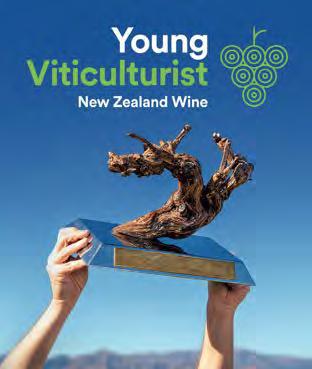
AS winter approaches, not only is there a nip in the air, but also a sense of anticipation and excitement as the wine industry builds up to the Young Viticulturist of the Year competition season.
Now in its nineteenth year, this programme helps grow New Zealand’s future viticultural leaders. Previous contestants, many now senior leaders in the wine industry, still appreciate how Young Viticulturist of the Year gave them support and a stepping stone to help advance their career.
“This competition gave me a great platform to grow my own career and I’m keen to help many more Young Viticulturists flourish and progress their careers in an industry I’m passionate about.” says Matt Fox, newly appointed Chair of the NZ Young Viticulturist National Committee. Matt was the 2013 national winner and is now the Viticulturist for Rapaura Springs/ Summerhouse Wines.
The NZ Young Viticulturist programme helps under thirty year olds upskill, stretch themselves and
in, but the flavour and quality is brought to the fore by incredibly skilled viticulturalists and winemakers,” Marcus says.
“In Marlborough, we have a phenomenally-skilled industry – we attract and retain some of the world’s best winemakers and trainees.
A remarkable provenance story
Marcus says another reason to celebrate International Sauvignon Blanc Day is the remarkable provenance story of Marlborough wine. In August 2023 the industry celebrated the 50th anniversary of Marlborough’s official beginning as a wine region.
“We have a lot to be proud of in Marlborough. Sauvignon Blanc is our signature wine that restaurants and hotels worldwide have embraced.
“It is worth reflecting on the fact that in those pioneering winemaking days, few people would have predicted Marlborough’s rapid ascent to become one of New Zealand’s preeminent – and internationally renowned – wine-growing regions.
“For many of our winegrowing pioneers – Frank Yukich, the Rose, Sutherland, Ibbotson, Marris and Scott families, just to name a few – it would have been gut instinct backed by climate science,” Pickens says.
network as well as giving them an opportunity to share their ideas about the future. The competitions are tough and the contestants are tested on all aspects of viticulture and vineyard management. They are also fun and bring a great sense of achievement.
Over the years a strong, supportive Young Vit community has evolved which includes previous contestants, wine industry members and sponsors who are specialist suppliers to the industry.
“It’s a very special community,” says Nicky Grandorge, Leadership & Communities Manager at New Zealand Winegrowers “and there’s
• Marlborough viticulture has expanded from 6,831 hectares in 2003 to the nearly 30,000 hectares of vineyard Marlborough boasts – about 71% of the national total.
• Annually, Marlborough produces 300 million to 400 million bottles of wine.
• Marlborough vineyards comprise 81% Sauvignon Blanc grapes
• Three-quarters of all Sauvignon Blanc is planted in Marlborough (23k+ ha), followed by Hawke's Bay (978 ha) and Nelson (610 ha).
• Sauvignon Blanc was commercially produced in New Zealand for the first time in the 1970s.
• It is the country's most widely planted variety, and is New Zealand's flagship export wine.
• Nationally, over 25,000 hectares of vineyard land are devoted to growing the grape .
• Sauvignon Blanc comprises 78% of New Zealand’s overall wine production — and it’s 89% of what we export to the rest of the world. The total production is: 378,300 tonnes.
a wonderful buzz at this time of year, as everyone starts planning, studying and coming together for the competitions”.
The regional competitions will take place throughout June and July with the national final taking place at Escarpment in Wairarapa on 28 August. The 2024 winner will be announced at the Altogether Unique Wine Industry Celebration in Wellington on 29 August.
Tai Nelson from Soljans Estate in Kumeu, Auckland was the 2023 NZ Young Viticulturist of the Year. Who will it be this year?
This year’s national winner will take home an amazing prize
• It's one of the parent grapes of Cabernet Sauvignon along with Cabernet Franc.
• Today’s Marlborough Sauvignon Blancs typically display zingy acidity, with a leap-out-ofthe-glass pungency and heady aromas of passionfruit, gooseberry and freshly cut herbs.
• They have a distinctive style that reflects the region’s hot days and cool nights. Those long summer days allow the sugars, or brix, to build, while the cooler nights allow the grapes to retain the acidity Sauvignon is best known for.
From a 2020 report by NZIER, The Contribution of Wine to the Marlborough Economy:
• the wine industry injected $571 million into the Marlborough economy
• 6,088 jobs currently in the region were either directly or indirectly associated with the industry
• In 2000 wine contributed to $119 million to the economy, increasing to $571 million by 2020 – ie, a 380% increase in 20 years.
package including a brand new Ford vehicle for a year, an Ecotrellis Travel Grant, a Leadership Week and cash prizes. A BioStart Hortisports winner will also be announced at each competition and all national finalists will be hosted by Fruitfed Supplies on a field trip. The competition is made possible thanks to the following generous sponsors: BioStart, Ecotrellis, Ford, Fruitfed Supplies, Agritrade, Clemens, Constellation Brands, Empak, Fendt, Indevin, Klima, Ormond Nurseries, Roots, Shoots & Fruits, Waterforce, NZSVO, New Zealand Winegrowers and Winejobsonline.

✱ Bannockburn winery Felton Road is The Real Review’s Winery of the Year New Zealand 2024
✱ Destiny Bay, Church Road, Ata Rangi and Craggy Range complete the top five
✱ Central Otago has shone this year, taking 36 of the 157 spots
✱ Female winemakers lead 35 of the listed wineries, supporting the growth of women in wine
ONE of Australia’s leading authorities in wine, The Real Review, has today announced its prestigious ranking of the top wineries of New Zealand, with Bannockburn producer Felton Road being crowned Winery of the Year New Zealand 2024. The results follow an intensive tasting of over 3,500 wines with some big movements up and down the list, and a number of new entrants to the top wineries.
The list is independently ranked by The Real Review tasting team, led by critics Bob Campbell MW, Huon Hooke, including Stephen Wong MW and others.
In top position for the first time ever, Felton Road, the winery that made Bannockburn famous, has never ranked lower than sixth place. Felton Road Winemaker Blair Walter said, “We are honored to be awarded Winery of the Year New Zealand in 2024 by The Real Review. We’re blessed in Bannockburn with our four vineyard sites offering such consistent and distinctly high quality wines. We’ve been farming our vineyards organically and biodynamically for over 20 years now which brings additional harmony and nuance to the wines.”
Completing the top five ranking
of this year’s list are Destiny Bay (#2, Waiheke Island), Church Road (#3, Hawke’s Bay), Ata Rangi (#4, Martinborough) and Craggy Range (#5, Hawke’s Bay).
Leading New Zealand MW Stephen Wong said, “I’m honoured to have recently joined Bob Campbell MW and The Real Review team for the Top Wineries of New Zealand–it’s the seventh release of this list, but the first which I have been part of. It is really heartening for me to see increasingly diverse representation in the list of winemakers, the stellar results from Central Otago, the outstanding dominance of organic producers and smaller regions like the Wairarapa, North Canterbury and Waiheke punching about their weight class alongside the juggernauts of Marlborough and Hawke’s Bay. It is an exciting time for New Zealand wine across almost every style and grape variety. There is much cause for optimism.”
Bob Campbell MW said, "Top Wineries of New Zealand 2024 is the Who's Who of fine wine producers creating new benchmarks as a measure of excellence. It is a one stop shop for the latest and greatest New Zealand wines and we are thrilled to reveal them to New Zealand wine lovers."
Released annually to highlight excellence in New Zealand wine, The Real Review awards the top New Zealand wineries that consistently produce excellent wine. The Top Wineries list represents a national benchmark that shows where New Zealander’s favourite winery is placed amongst its peers. This year has seen producers catapult up the rankings significantly with Fromm, Dog Point, Obsidian, Cloudy Bay and Black Estate all jumping from rankings below 50 into the top 30.
The representation of the different wine regions in the list and the high proportion of the top wineries with certified organic vineyards is also notable. Within the top 60, 34 wineries in total (56.7%) have some or all of their vineyards certified organic. Marlborough predictably leads the pack with 48 wineries on the list of 157, with Central Otago shining at 36 wineries. Auckland surprisingly has 13 entrants, 11 of which are on Waiheke Island.
A nod to women in wine, 35 of the listed wineries have female winemakers at the helm, representing over 21% of the total wineries on the list - an everincreasing presence that continues to grow year-on-year.
THE conference schedule for WinePro has been announced! The theme of the schedule is Innovate, Elevate, Celebrate, consisting of thought-provoking talks and panels in the fields of tech, environment, labour, the future of the industry and so much more. Speakers & panellists include doctors, CEOs, government officials, representatives from businesses & trusts and the New Zealander of the Year for 2024!
Tech Advancements -
• AI in Wine - Rachel O’Shea from Yabble will go through cases of AI use for the wine industry from research and innovation to international markets and beyond.
Sustainable Practices -
• Frugal Bottle Revolution - The world’s first paper bottle for wine and spirits which reduces carbon output by 84%. Video from Frugalpac with Malcolm Waugh CEO supported in person by Mother of Pearl and Mothers Ruined to explain their story.
• Climate & Viticulture - Seasonal climate changes and how this affects viticulture: Building resilience. Hosted by Dr Jim Salinge, Kiwibank New Zealander of the Year 2024.
• Vineyard Redevelopment Everything you need to know about the vineyard redevelopment process. Guideline of the do’s and don'ts. Hosted
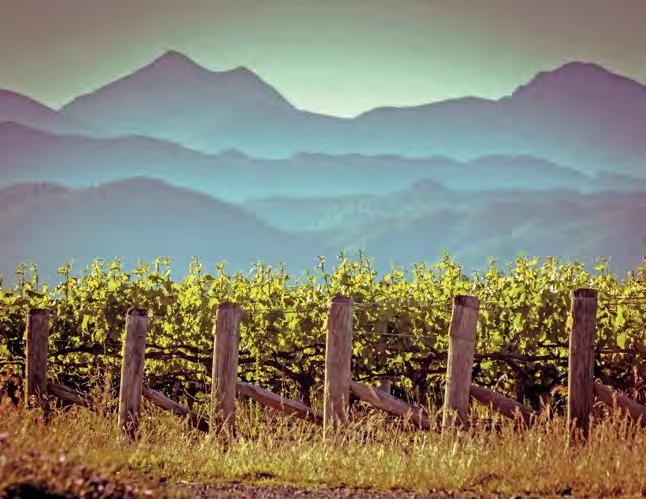
by Stuart Dudley and a selected viticulture industry panel.
• Reinventing Fining - Learn about the latest in sustainable alternatives for fining and the technological advancements empowering winemakers to tailor the sensory of their wines, with precision – and, without excessive waste. Hosted by Jonathan Engle of amaea.
Emerging Industry Trends -
• Automation in Agriculture What is the problem trying to be solved? Where are we now with automation? Does it reduce our labour needs? What are our expectations, what is the big dream, and where could it go? Hosted by Josh McCulloch, Autonabit, Andrew Kersley, Smart Machine & Brock Campbell, Cloudy Bay.
• Future Labour Challenges - The
future demography of regions will continue to change with implications for labour supply What will New Zealand's population look like in 2038 and are New Zealand's rural and primary sectors prepared for this? Hosted by Prof. Emeritus Paul Spoonley.
• Understanding the Wine Industry’s Workforce - A national wine industry research project has discovered common themes in wine industry workforce trends across NZ and Australia. Hosted by project lead, Amanda Reid from BERL.
Growth Opportunities for NZ Wine -
• What is the government’s roadmap to doubling wine export value? - Hosted by Jenny Cameron - MPI Chief Transformation Officer.
WITH a rich history rooted in the Hawke’s Bay region, Church Road is renowned for being the first in New Zealand to craft exceptional quality Bordeaux style red wines. Inching close to 130 years of winemaking excellence, Church Road strives for consistent evolution of their wines while continuing to harness the
character of the region’s terroir.
The Top Wineries lists are initiatives developed by The Real Review to identify and reward wine excellence across Australia and New Zealand so it is a fantastic achievement to be recognised for continued admirable winemaking efforts.
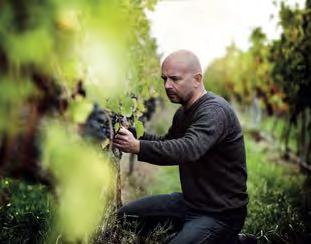

DON’T miss out, enter now to showcase your exceptional wines.
Entries are now open for the 2024 New World Wine Awards,
and the search is on for the most delicious and affordable wines, with wineries from around Aotearoa and the world invited to enter their wines under $25.
Entries can be submitted online, and close on Friday 21 June.
After three days of blind judging, the top ranked under $25 wines will claim their spot in the Awards’ prestigious Top 50 under $25.
The Top 50 will receive nationwide distribution in more than 140 New World stores as well as comprehensive marketing and promotional support in-store and out.
“Now in its 22nd year, the New World Wine Awards offers a fantastic opportunity for wineries and distributors to showcase their
top drops to customers in New World stores across both the North and South Island,” says Rachel Carter, who leads the category for Foodstuffs North Island.
“Many people associate great wine with a high price tag, but a big part of the awards is about helping our customers find top quality drops without breaking the bank.”
Entrants do not have to be existing Foodstuffs suppliers to enter – what’s key is the ability to supply enough product in the event of a win to satisfy New World’s wine-loving shoppers. There is a minimum volume of at least 4,000 bottles, or 1,800 for emerging varieties to help encourage an even wider spread of styles and producers to enter.
“SOME OF THE MOST THRILLING WE’VE SEEN.”
It’s the day wine lovers across the country most eagerly await and an absolute highlight on the Hawke’s Bay calendar. Tickets are now on sale for the Hawke’s Bay Wine Auction 2024, with many of this year’s lots more extraordinary than ever.
The Hawke’s Bay Wine Auction is many things: a celebration of the region's outstanding wine industry, an elegant occasion for the winemakers and wine connoisseurs in attendance, and a fun day out for hundreds of locals and visitors keen to get together and sample the best drops in the country.
It’s also the largest annual private contributor to Cranford Hospice each year, and for that reason alone, holds a very special place in Hawke’s Bay hearts. Last year’s auction raised over $300,000, and already, one of the 2024 lots is expected to spark a bidding war.
For the very first time, a private collection spanning not 10, or 20,
but an impressive 40 years of Te Mata Estate’s prestigious Coleraine will be offered at auction. This exceptional collection features a bottle from each feted vintage, from its very first in 1982, through to 2021 (with 1992, 1993 and 2012 being non-producing years). The 37-bottle lot, generously donated by local wine enthusiast Stuart Tustin, showcases four decades of arguably New Zealand’s most iconic red wine, and is most certainly a once-in-a-lifetime opportunity.
Having carefully cellared the collection since he purchased his first case of Coleraine in the 1980s, Stuart says it became clear he could “never break it up,” and decided to donate the bottles for good. “This feels like the perfect opportunity to find a new home for the collection, at a healthy price, and support a fantastic facility,” he says. “I hope we do it justice.”
Among the remaining 40 lots on offer this year (everything from
special magnum collections to quarter, half and full barriques), bidders may be tempted by the opportunity to purchase Syrah blended from the eight wineries in the Bridge Pa Triangle, expertly crafted by winemakers Barry Riwai and Jason Stent. The Barrique (300 bottles) of Bridge Pa Triangle Wine District Syrah 2024 En Primeur is highly scented, aromatic and savoury.
Another celebrated wine lot; the 2023 Church Road Chardonnay. Named Best in the World at this year's International Wine Challenge, Church Road consistently produces incredibly high-quality Chardonnay and this exclusive lot – a unique blend of top Chardonnay parcels – is another standout, with 150 bottles (a half barrique) on offer.
Those looking for a tropical escape, original artwork or an exclusive dining or tasting experience are also catered for, with
Alongside fan favourites like Sauvignon Blanc and Pinot Noir, the Awards present a great chance for lesser-known wines to step into the spotlight.
“When you see a bottle of wine sporting a winning Top 50 Gold medal, you know it’s been through a rigorous judging process, and that helps give shoppers the confidence to venture outside their comfort zone and try something new – be it a new brand or a new variety of wine,” says Rachel.
Judging takes place over three days with an independent panel made up of experts from across the wine industry, including respected winemakers and industry professionals. Jen Parr will return as the Chair of Judges.
The judging is ‘blind’, meaning the judges only assess the wine in the glass on the day, and do not know the brand of any entry.
The panel will evaluate each wine on appearance, taste, and smell, making collective scoring decisions according to the internationally recognised 100-point system to award Gold (95-100 points), Silver (90-94) and Bronze medals (85-89).
The top scoring wines will be tasted once again by all Senior Judges to determine the Top 50, and identify the Champions of each main varietal, and an overall Champion Red and Champion White.
There are also entry opportunities for non-alcoholic wines and wines over $25.
Visit newworld.co.nz/topwines for more information, or go directly to entries.newworld.co.nz to submit an entry.
The full results will be announced later this year.
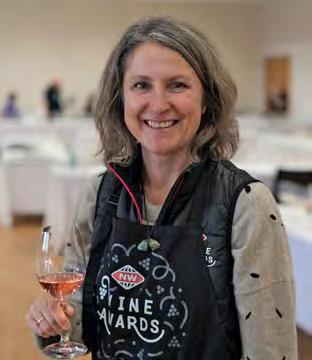
lots including a seven-night Pacific travel package from House of Travel and Reef House, a one-off still life artwork courtesy of feature artist Helen Kerridge, a library tasting for 20 at Pask Winery or dinner for 12 at Crab Farm.
“It has to be noted that some of our 2024 lots are without doubt the most thrilling we’ve seen,” says Hawke’s Bay Wine Auction Chairman and former winemaker Peter Cowley. “We’ve been blown away by the quality of the lots so generously donated by winemakers and supporters, and the excitement that is building as we head into the auction is palpable.”
The first opportunity to sip and sample the wines on offer takes place on Wednesday 14th August at the Napier War Memorial Centre with the auction itself, including a tasting prior to the gavel being lifted on the first lot, at Toitoi Hawke’s Bay Arts and Event Centre on Saturday 14th September.
Event Ambassador and host Mike McRoberts will join the fun for the fifth year running. Travelling to Hawke’s Bay for the annual auction is a chance for the journalist and new National Business Review Te
Ao Māori Editor to mingle with fellow wine lovers and enjoy the excitement of the experience.
The auction’s General Manager, Samantha Kershaw, notes that having Mike on board is also something to celebrate. “Mike has had a turbulent year with the closure of Newshub, but despite the upheaval, he’s remained absolutely committed to, and passionate about, his role as our Ambassador. We’re eternally grateful to him for putting in such an effort to support the Hawke’s Bay Wine Auction.”
And Samantha’s advice to anyone wanting to have a go at securing either the Coleraine vertical, or one of the other fantastic lots? Recruit friends and family, build your auction syndicate, buy your tickets and have a punt. “It’s all for the very best of causes – ensuring a sustainable future for our wonderful local hospice.”
To see all lots on offer at the Hawke’s Bay Wine Auction 2024, and purchase tickets for both the 14th August and the 14th September, go to www.hawkesbaywineauction.co.nz.
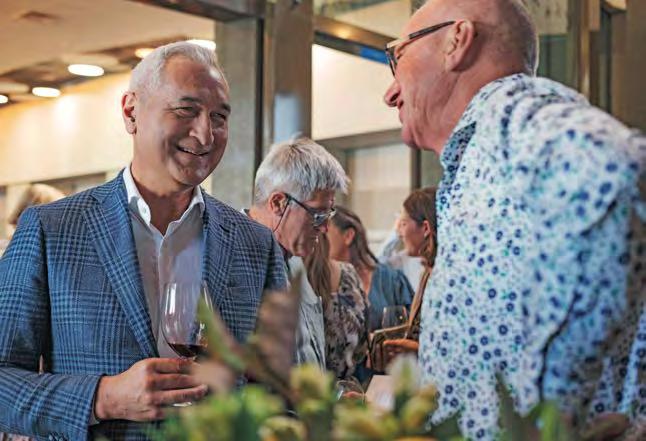

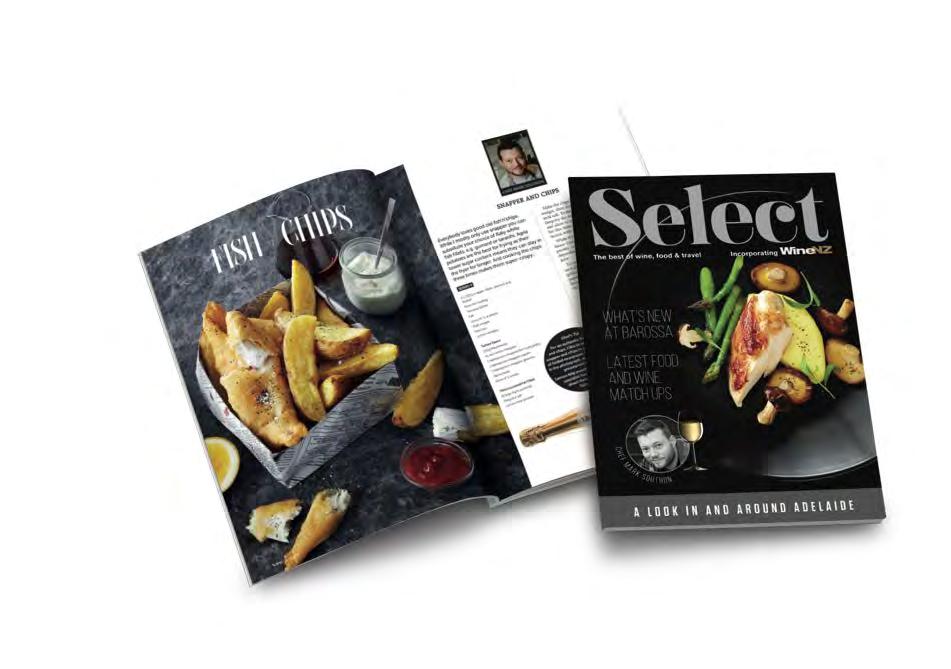












In the dance between time and taste, wine tells a story unlike any other. Each bottle holds not just liquid, but a piece of history, a moment frozen in time. Yet, as seasons shift and temperatures rise, the delicate balance of preservation becomes paramount.
In most parts of the world, the heat of summer prompts thoughts of cellaring, a practice essential for safeguarding the essence of fine wine. However, in the heart of New Zealand, where the cool whispers of winter reign supreme, a different narrative unfolds—a tale of the Winter Chill effect.
In the embrace of winter's cool grip, the very essence of wine preservation takes centre stage. Here, amidst the serene landscapes of Mount Eden and Wairau Valley, Kennards Wine Storage stands as a bastion of protection for your cherished bottles.
We are Guardians of Flavour at Kennards, we understand that your
wine collection is more than just a gathering of bottles; it's a tapestry of memories, a testament to taste. That's why we offer private lock-up cellars, each a sanctuary for your most treasured vintages. With no handling fees or access charges, our transparent monthly rental system grants you peace of mind and easy access to your collection.
Temperature and humidity—two elements that shape the destiny of every bottle. In our climatecontrolled facilities, these factors are meticulously monitored, ensuring stability and consistency. From the gentle coolness of winter to the balmy embrace of summer, Kennards Wine Storage maintains an ideal environment for your wines to evolve gracefully.
Our temperature control systems ensure the cellar temperature is very stable, typically maintaining 14°C (+ or - 1°C). This stability is not just about preserving the wine; it's about safeguarding its story.

Imagine each bottle as a chapter waiting to unfold, its flavours evolving gracefully within the confines of consistent temperature. Similarly, our cellars maintain moderate humidity levels (55%75%) to avoid problems like cork shrinkage, leakage, mould, and contamination. This balance of humidity not only ensures the physical integrity of the cork but also preserves the essence of the wine itself. In the dance between preservation and evolution, temperature and humidity play crucial roles, nurturing each bottle's potential to tell its unique story.
In our cellars, you're not just a tenant; you're the curator of your own collection. Bid farewell to the risks of frequent handling and exposure to light. With 24/7 access and our convenient Wine 'Drop' Service, managing your wines becomes a seamless experience. Whether it's a midnight craving or a spontaneous celebration, your collection is always within reach. Choose from our range of cellar sizes to suit your needs:
12 to 72 Case cabinets, perfect for your personal collection.
100-500 case walk-in cellars, for larger collections, restaurants, importers, investments, and more!
As a token of our commitment to preserving your wine's story, we extend a special offer—30% off the current market price on your chosen wine cellar at Kennards Mt Eden and Wairau Valley. Embrace the journey ahead with confidence, knowing that Kennards Wine Storage is your steadfast companion in every sip and celebration.
Step into a world where stories are preserved, flavours are cherished, and memories are uncorked experience Kennards Wine Storage today.
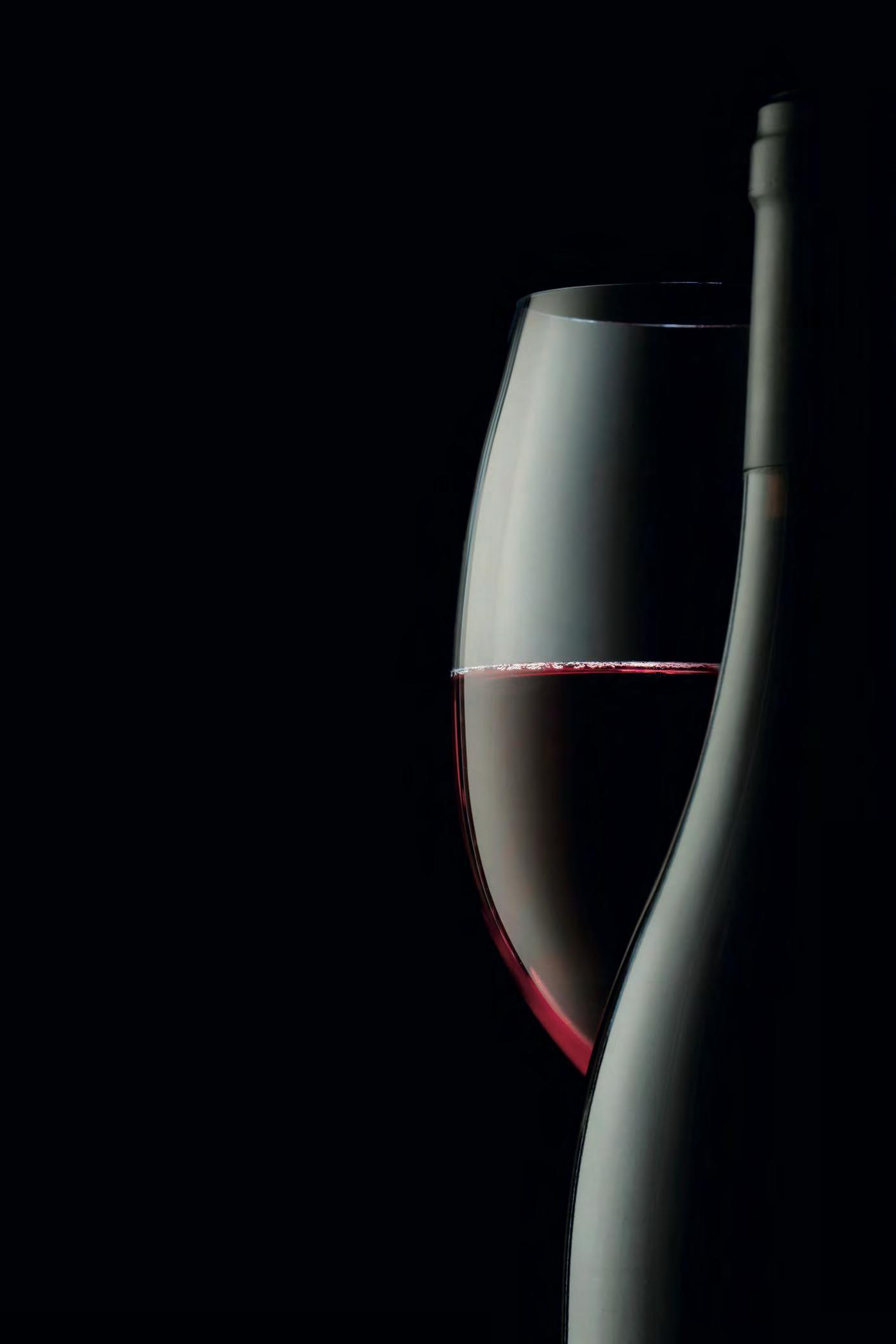


Thirty minutes from Auckland’s city centre are a handful of wineries with venerable histories that have reinvented themselves for modern times. Charmian Smith explores the West Auckland cellar doors.
AT one of Henderson’s major intersections stands a statue of an early winemaker acknowledging the founders of the West Auckland wine industry. Most were Croatians, at the time known as Dalmatians, who came to New Zealand the early 20th century to dig kauri gum. Missing the wine of their homeland, they planted small vineyards, many in Lincoln Rd and up the Henderson Valley.
Besides table wine for their own consumption, they made sweet fortified wines - port and sherry styles - for sale. That was the public’s preference from the 1930s into the 1970s.
But as tastes changed to varietal table wines and urban sprawl increased the price of land in West Auckland, many wineries closed or moved operations out to Kumeu and Waimauku or to new wine regions like Hawkes Bay or Marlborough.
However, one winery, the last in Lincoln Rd, has changed remarkably little. Mazuran’s old fashioned shop is attached to a small winery sandwiched between other buildings and the former pocket vineyard which was recently planted with olive trees.
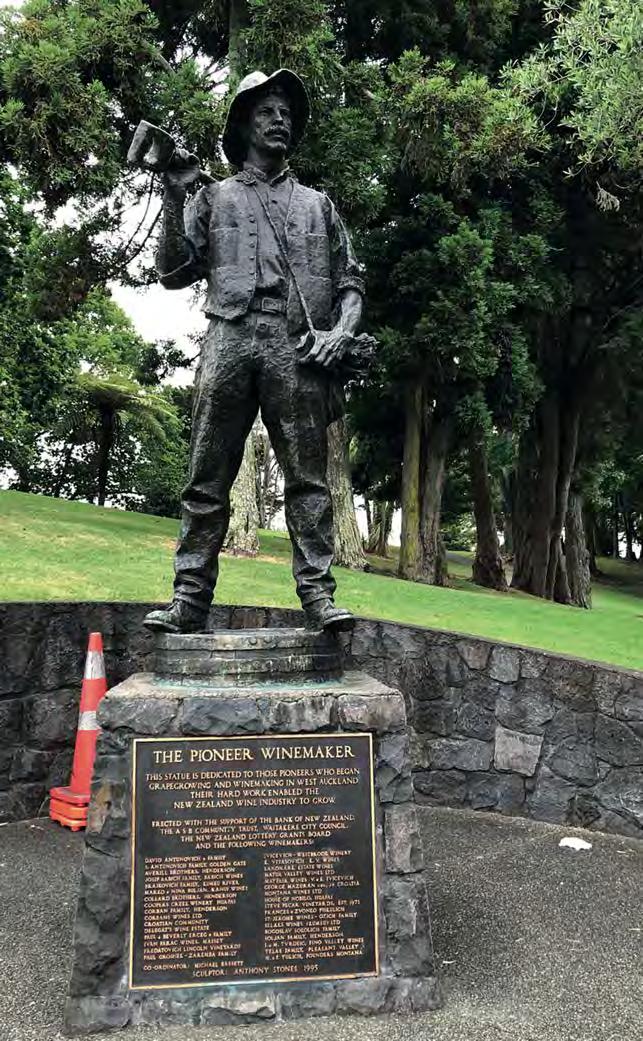
Founded in 1938 by George Mazuran and his wife Florence, it is now run by their grandson, Tony Mazuran who makes fortified wines as his grandfather and father did. Besides sweeter ports and sherries, there is also a range of varietal wines introduced by Tony’s father in the 1970s and ‘80s, now made for them in Gisborne.
But it’s the fortified wines that are the attraction. If you are looking for a wine from your birth yearanything after 1942 - you will find a vintage port here. The oldest ones are upwards of $1000, reflecting the long ageing and evaporation that changes young, light wines to dark, syrupy mellow ones, according to Tony Mazuran.
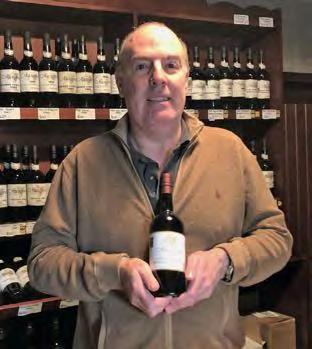
Most of his ports and sherries, ranging from the 10-year-olds to the 85th Anniversary blend, are made in a solera system. Older wines are drawn off for bottling and the barrels topped up with younger ones.
Ports are now made from cabernet sauvignon and merlot, sherries from palomino and muscat. After fermentation they are fortified with spirit distilled from grape skins and pips.
Mazuran’s Old Tawny Port ($85) is fragrant, luscious, rich and sweet with hints of toffee and smoke - a delicious sip. It is half 50-year old wine and half 10-15 year old blends, Tony says. mazurans.com
Most of the cellar doors in West Auckland are found along Highway 16 in Kumeu and in the hills beyond Waimauku. Chardonnay is the star in this region, but I tasted several stylish albariños which do well in the mild climate and clay soils. Look our for this up-and-coming variety. Pinot gris grown here can be attractive with exuberant fruit, and some interesting reds such as pinotage can be found.
chardonnays inspired by the great wines of Burgundy. Kumeu’s new chardonnay-based crémants (méthode traditionelle) would give not a few prestigious Champagne cuvées a run for their money.
The tasting room is simple, built on the front of the winery, but the wines are outstanding. Behind is a small storeroom Paul Brajkovich calls the R&D department, stacked with some of the finest wines from around the world.
“If you are going to make world class wine you have to taste world class wine. We drank a lot of champagne when researching the crémant,” he says with a laugh.
Established as San Marino in the 1940s by Mick and Katé Brajkovich from Croatia, it was built up by their son Maté and his wife Melba who moved to varietal wines. In the 1980s, the third generation, Michael (Master of Wine), Milan and Paul became involved. They changed its name and have since focused on quality and reputation. Their sister Marijana has joined the team and her son may well be the fourth generation to join the family business.
With local vineyards on clay soils increasingly hemmed between suburban blocks, the Brajkovichs bought a vineyard in Hawkes Bay a few years ago.
They produce a couple of pretty pinot noirs, a rosé and a fresh pinot
gris, but the chardonnays are the stars.
Starting with a deliciously crisp, slightly nutty Village Chardonnay ($25) the range moves up to the rich, slightly crisp Rays Road Hawkes Bay Chardonnay 2022 ($40), and on to the single vineyard chardonnays from single Kumeu vineyards.
Coddington Chardonnay 2022 ($70) is plush, luscious and complex.
Hunting Hill Chardonnay 2022 ($90) has obvious citrus noteslime blossom, lemon and peach, and is textural with a delicious, crunchy, lip-sucking finish.
The flagship is Maté’s Vineyard Chardonnay 2022 ($95) from the vineyard across the road from the winery, the original land bought by Maté Brajkovich and his parents in the 1940s and replanted in the early 1990s. It’s luscious, dense, creamy, silky, and harmonious.
Not people to rest on their laurels, the Brajkovichs expanded into crémant, the French term for méthode traditionelle sparkling wine made outside Champagne.
Kumeu River Crémant ($50) is fresh and zesty, hinting of creamy brioche with caramel and nuts, a blend of 60% chardonnay and 40% pinot noir.
KUMEU RIVER
Kumeu River winery is renowned internationally for its range of chardonnays from the affordable Village wines to the dense, complex single vineyard
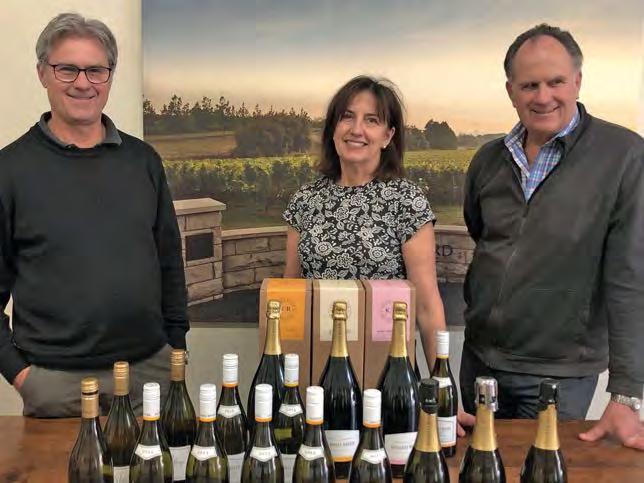

Crémant Rosé ($50) is a pretty pink with a delicious nutty undertone and a distinctive suggestion of freshly baked brioche. It is also 60% chardonnay and 40% pinot noir, coloured with a little pinot noir.
Top of the line is the Crémant Blanc de Blanc ($75), 100% chardonnay, redolent with nutty, creamy hints of freshly baked brioche. It’s textural with a lovely fresh acidity and a delicious lingering finish. kumeuriver.co.nz
Soljans is the first winery you’ll come across when heading northwest from Auckland along SH16. Surrounded by vineyard, the spacious cellar door and shop lead to the bistro and function centre opening onto a pergola and garden, making it a pleasant place for breakfast or lunch.
One of the oldest wineries still owned by its founding family, it was established in 1932 by Bartul Soljan and his wife Rakelina. Tony Soljan, their grandson moved the winery from Henderson to Kumeu in 2002 and is now joined by his grandson, Tyler Soljan - although Tyler says he and his sister Amber have helped out in the family business ever since they could walk.
Tony moved from fortified to table wines but tradition is respected with their smooth fragrant Founders Tawny Port ($45) - the youngest portion is 10 years old. It is matured in large totara


barrels, an important part of the finishing process, Tyler says.
A couple of bubblies are made: the popular Fusion, a light sparkling rosé and moscato; more serious is Legacy Méthode Traditionelle, ($42), a blanc de blanc (chardonnay), fresh, deliciously nutty with a very long aftertaste.
Two chardonnays make an interesting comparison - the toasty, nutty, full-on Fifth Generation Kumeu Chardonnay 2019 ($52) and the ripe-fruited, textural Barrique Reserve 2000 ($32) from Hawkes Bay.
Pinot gris 2021 ($24) from the home vineyard is fragrant and lively.
Worth tasting is a local specialty, pinotage, a red variety originally from South Africa that used to be grown widely. Soljan’s 2020 ($36) is fragrant, slightly smoky and savoury with dry, firm tannins. soljans.co.nz
COOPERS CREEK
Coopers Creek's spacious tasting room and shop at Huapai is entered beneath a wisteria pergola. There’s a small home vineyard and winery behind, but most of the grapes now come from Hawkes Bay and Gisborne.
Established more than 40 years ago by Andrew and Cyndy Hendry, this is one of the “younger” wineries in the region. It is also one of the more innovative with a range of unusual varieties such as albariño, marsanne, largrein and montepulciano.
However, chardonnay is the star in their portfolio. People who love big, oaky chardonnay will appreciate their Select Vineyard Big and Buttery Chardonnay 2022 ($23) from Gisborne, hinting of citrus with loads of toasty, spicy oak; and the Select Vineyard Limeworks Hawkes Bay Chardonnay 2020 ($23), oozing
sweet, peachy, tropical fruit and oodles of creamy, spicy oak.
A more classical style only made in the best vintages is the black label Swamp Reserve Hawkes Bay Chardonnay 2020 ($40), elegant, creamy and silky, with a long finish.
Among the less common varieties, my favourite was the Select Vineyard “Bell Ringer” Albariño 2020 ($22) from Gisborne, exuding hints of melon and orange peel, full bodied, silky and long.
I was also seduced by Select Vineyard “Guido in Velvet Pants” Montepulciano 2018 ($28) from the home vineyard in Kumeu. It’s lively, peppery, and velvety. The curious nickname refers to winemaker Simon Nunns’ dog called Guido and an obscure reference to an order of Carmelite Nuns, who, delighted by a new wine from their vineyard, exclaimed: "It slips down the throat as easily as the Infant Jesus in velvet pants”.
Besides the Swamp Reserve chardonnay, the other star of this visit was the Reserve Hawkes Bay Syrah 2018 ($60) from limestone soils in the hills. Dark fruit aromas morph into intensely rich ripe berry fruit with hints of spice, supple, dusty tannins, and lingering aftertaste.
cooperscreek.co.nz

Waimauku is the glorious park-like setting of Westbrook. Originally called Panorama, it was founded in Henderson in 1935 by Mick Ivicevich and his young son Tony. Mick’s grandson Anthony eventually took over and in 1999 moved the winery to its present setting and planted the vineyard. It changed hands a few years ago allowing more landscaping and building extensions, but winemaker James Rowan is still there after 17 years ensuring continuity.
syrah from Waiheke alongside the local chardonnay, pinot gris, albariño and malbec, and couple of sparkling wines, there’s a wide choice.
Waimauku chardonnay is their star, says Jasmin, and the 2018 ($45) hints of citrus and peach, and is textured, nutty and elegant.
Also from the home vineyard is a lush pinot gris 2020 ($26), richly oozing melon, pear and citrus.
Tucked away up Ararimu Valley Rd in the hills north of

The charm of this destination winery and its landscaped grounds are obvious as you walk from the carpark along the pergola and veranda to the cellar door. A small lake partly covered with waterlilies lies in the natural amphitheatre below, surrounded by trees and the vineyard saunters up the slope behind.
“It’s a working winery first and foremost,” says Jasmin Nicholson from the cellar door team.
“It’s very photogenic and peaceful, considering how near town it is. It’s mostly grown by word of mouth and reputation.”
It is certainly a lovely place for a long, casual lunch.They serve platters and pizzas with winematching options.
With sauvignon blanc, riesling, chardonnay and pinot noir from Marlborough and the stunning
Like other growers in the region Westbrook has planted albariño and their first vintage, 2001 ($45) shows fresh apple and pear with an undertone of mineral, and a refreshing finish.
Westbrook Waiheke Syrah 2019 ($44) is another highlight, fragrant with red berries, subtle, almost cuddly tannins and a vibrant finish. westbrook.co.nz
The Hunting Lodge sits among rolling hills and vineyards in the Waimauku Valley. The historic house was originally the cellar door and restaurant of Matua Valley founded in the late 1960s by Ross and Bill Spence of Dalmatian heritage. When Matua was sold to Beringer-Blass Wine Estates in 2001 the winery and surrounding vineyards were bought the Sutton family.
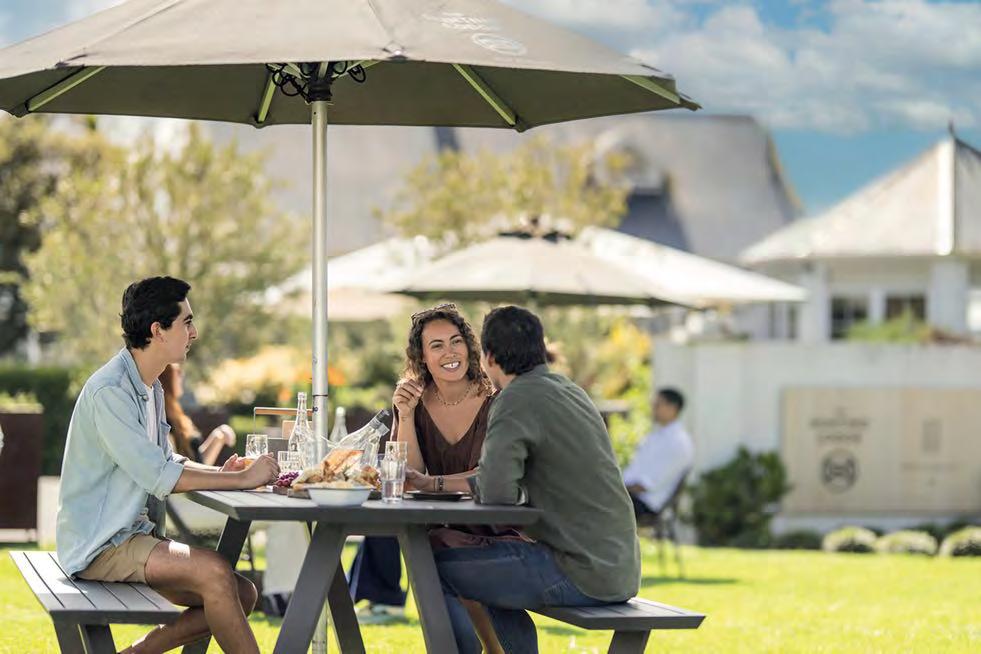
There’s now a busy casual lawn bar offering pizzas and burgers, a fine dining restaurant in the historic house and a function venue in the Barn that was once Matua’s tractor shed.
James Pritchard, formerly winemaker at Matua Valley, stayed on and is keen to show the provenance of the region. Their Home Block wines from three local vineyards include some of the oldest sauvignon blanc vines in New Zealand, planted about 50 years ago by the Spence brothers.
Hunting Lodge also produce a Seasonal range from Hawkes Bay and Marlborough, and Expressions, a simple, approachable supermarket range, There are also fun drinks including Blush Crush, a sweet sparkling pink wine, RTDs and Noughty, alcohol-free fizzy beverages.
Home Block Sauvignon Blanc 2021 ($33), which includes grapes from the 50-year old vines, has been barrel fermented and oozes herbal and mineral notes, and is beautifully textured and has a delicious fresh, creamy aftertaste. Compare it with the simple Expressions Vibrant Marlborough Sauvignon Blanc $24) which

hints of green capsicum, and the more classic Seasonal Organic Marlborough Sauvignon Blanc ($25) with suggestions of fresh gooseberry, currant leaf and a slightly nutty texture.
The two charming albariños are also fascinating to compare . Seasonal Marlborough Albariño 2023 ($28) is powerful with hints of herbs and flowers, lovely fresh fruit and a bright clean finish.
Home Block Waimauku Albariño 2022 ($40) tends towards baked stone fruit and is textural with a long aftertaste.
Seasonal Marlborough Largrein 2020 ($38), a densely coloured, northern Italian varietal, is fragrant with cherries and dark fruits, lively and bright with soft, chalky tannins.
“For me the joy comes when other people enjoy the product you’ve made,” says James.
“It’s all about people socialising, enjoying the company of others and a nice bottle of wine on table.” And the Hunting Lodge is all about socialising and enjoying the wine. thehuntinglodge.com
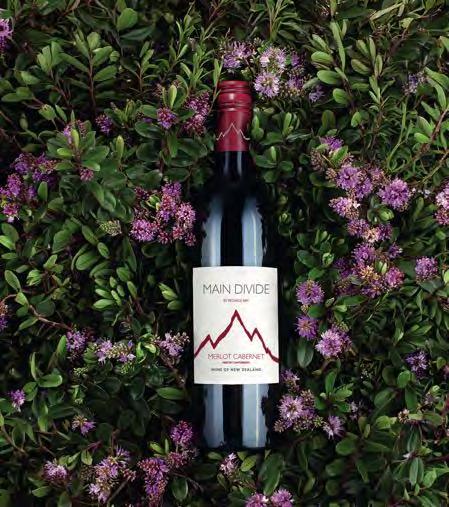


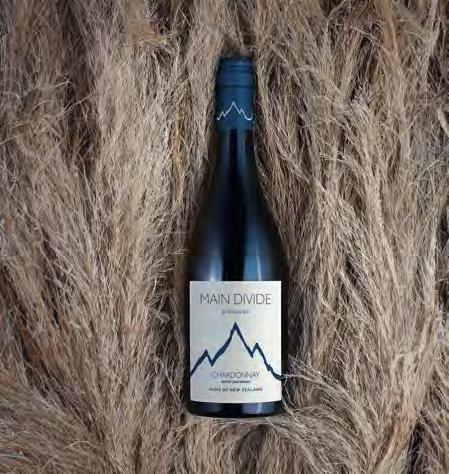




By using locally sourced ingredients, Kaimai Brewing and Distilling Company demonstrates an incredible knack for catering to a more refined palate. Serving bars, restaurants, and retail stores throughout New Zealand, this single batch gin distillery has made quite the name for itself across the region. In light of its well-deserved success within the Distillery and Brewing Awards 2023, we venture through Kaimai Distilling Company’s processes and passions, and how owners Wayne and Kathy Chowles consistently deliver on its promise of perfection within each of its unique blends.
SINCE ITS INCEPTION, Kaimai Distilling Company has been focused on one sole goal – to create high-quality, one-of-a-kind spirits for its customers to enjoy. Whether it’s supplying some of the region’s most renowned establishments with its bountiful flavours, or selling its bottled bliss to consumers via its online store, Kaimai Distilling Company invites individuals to sample some of the best gin that New Zealand has to offer. It goes above and beyond to source only the highest quality of ingredients for its products, guaranteeing a freshness that directly contributes towards the empowerment of the local community. As such, Kaimai Distilling Company has garnered immense popularity for both its flavours and ethics.
What truly makes Kaimai Distilling Company unlike
other distilleries, however, is its dedication to its unique methods such as using a Soxhlet Extractor to distil and isolate exceptional flavours from complex botanicals like truffles. So, it comes as no surprise to learn that, through such methods, it has accumulated a catalogue of incredibly diverse tastes. Creating innovative products is where Kaimai Distilling Company truly thrives – a quality that manifests through its desire to consistently experiment with new botanicals in order to concoct the next fan favourite flavour.
In addition to all of these impressive characteristics, Kaimai Distilling Company ensures quality down to the very water that acts as a base for each spirit. Said water is expertly sourced from a 50,000 year old artesian aquifer, which ultimately makes it among the purest in the world.
By combining all of these factors, Kaimai Distilling Company manages to consistently generate blends that marry innovation and creativity in perfect harmony. By placing immense emphasis on all of these individual qualities, Kaimai Distilling Company has placed itself among some of the top contenders within the competitive spirits industry – a feat of which it is immensely proud.
Despite being a relatively new distillery, having only been operating for six years, Kaimai Distilling Company has adapted itself in order to reach a wholly unique position within the industry. This is accomplished, of course, through the variety of unique gins and spirits that it has to offer. Partner this with the fact that the distillery frequently offers tastings to a variety of customers throughout the region, and you’ve got a business that’s truly invested in seeing its consumers smile. It lives and breathes its blends – something that becomes abundantly clear from the very first sip.
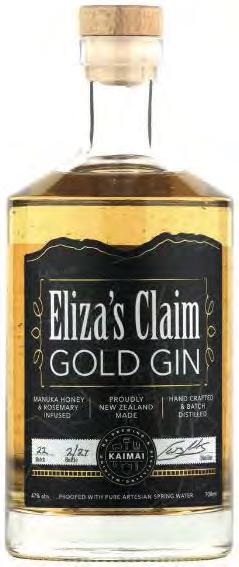




Ultimately, we’re incredibly excited to be recognising Kaimai Distilling Company as our Best Hand-Crafted Single Batch Gin Distillery 2023 - North Island NZ. We have found it to be very evident that this company has become such an industry leader, showing the true versatility, innovation, and resilience needed to defy the odds in a very competitive market. From the humble beginnings of a single batch of overripe feijoa and a tiny still becoming Wayne and

Boutique Distillers ma king uniquely smooth small batch gin
Insert photo here
Our gin is proofed with pure artisan spring water and infused with a range of locally and internationally sourced botanicals which combine to create a truly unique flavour.
Conta ct us for your bespoke wedding fa vours


Kathy’s first batch of “very average” spirits, the company has gone on to expand its range to five styles of gin, a spiced rum, and the newest addition of honey moonshine!
Truly worthy of celebration!
A key contributor to Kaimai Distilling Company’s astounding success, too, is its commitment to creativity, which we find to be incredibly inspiring – and we’re sure that this will only continue as it discovers new and inventive flavours in the coming future.

With a bright few years ahead of it, Kaimai Distilling Company can only flourish. We’re sure that, as it does, it’ll maintain its astounding eye for invention. As of now, Kaimai Distilling Company is in the best position it could possibly be – one where it has every chance of succeeding within New Zealand’s competitive distillery industry. We wish Kaimai Distilling Company all the best luck in its ventures, and we can’t wait to see what gins and spirits it brings to the world next.
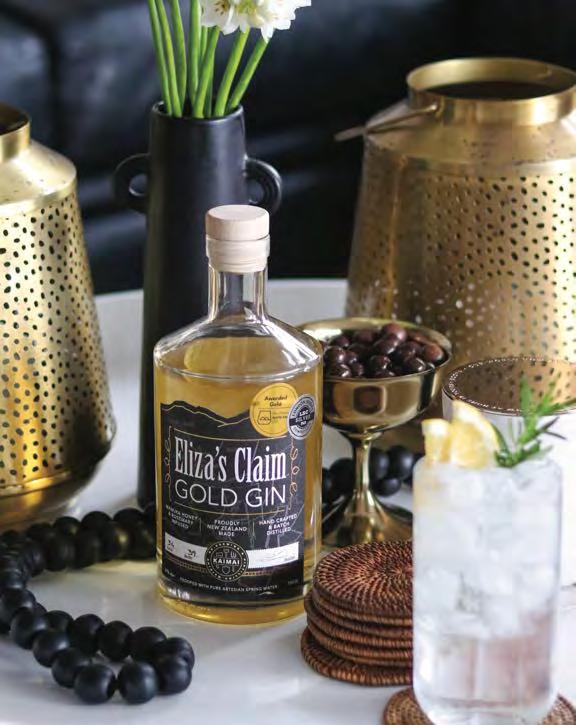
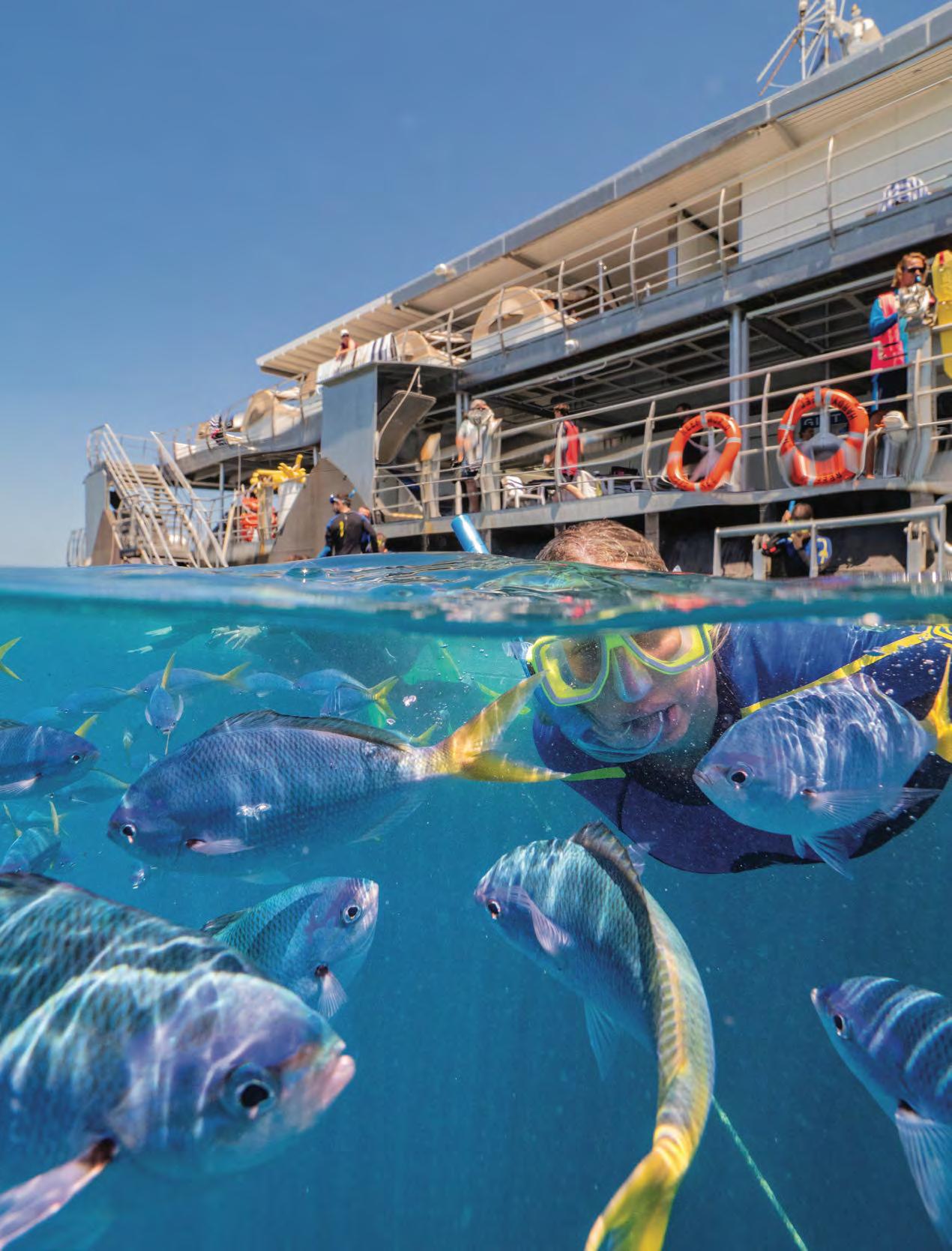
Dennis & Rosamund Knill discover one of Australia’s most idyllic coastlines and a place where you might want to stay forever.
AWAY from the coastline between Cape York in the north and Bundaberg in the south lies the Great Barrier Reef one of the world’s great wonders of the world. Alongside are the Whitsunday’s, the ideal getaway for those wanting to escape the maddening crowds and the pressures of city life.
It was Captain James Cook in 1770 who discovered and named this beautiful group of islands scattered on both sides of the Whitsunday Passage. Curiously, Cook misnamed them as he didn't really sail through them at all on Whit Sunday, and in fact he was a day late.
As the aircraft begins its descent, we can see the Whitsunday’s below beginning to unfold. Made up of seventy-four volcanic islands dotting the Great Barrier Reef rising from an ocean of turquoise and emerald green, some towering like pyramids above the sea, densely covered with pines and tropical rain forest.
Not to be outdone with its own airport and a bustling marina, Hamilton Island is the fun island and the most developed. Although rather like a small town in another world, it’s a high-end destination that has evolved from a small hideaway to a much sought after playground for the rich and famous who jet in and sail out. For most that come here, it’s a place with little to do but relax or spend time sunbathing, snorkelling and swimming. And if you’re not a beach bum there are plenty of leisurely walks, sailing, or golf on the only course in Australia that’s built on its own island.


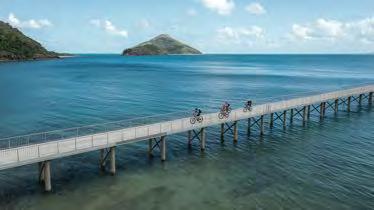
There’s also a variety of sea cruises that operate daily out of Hamilton Island with visits to the Great Barrier Reef. Not a solid structure, but rather a maze of 2,900 reefs, 950 islands spread languidly over 2,600 kilometres, this vast coral spectacle and the world's largest living structure occupies 350,000 square kilometres of marine territory. It’s the world’s largest marine park, larger than the Great Wall of China and the only living thing on earth visible from outer-space.

“There are pontoons moored right on the edge of the reef where you can dive and snorkel for hours, feed the fish or view the coral and the amazing fish life from partly submerged minisubmarines. You can even stay overnight on board a pontoon, an experience not to be missed.”
There are pontoons moored right on the edge of the reef where you can dive and snorkel for hours, feed the fish or view the




coral and the amazing fish life from partly submerged mini-submarines. You can even stay overnight on board a pontoon, an experience not to be missed.
Touchdown on the tarmac and we get our first taste of Hamilton Island. As the aircraft door swings open our senses are alerted with the balmy air that envelopes you and the sight of golf buggies buzzing around madly in all directions. Our first impressions, is this fantasy island? Luggage collected, we transfer to the adults only Qualia Resort, a six-star multimillion dollar hot spot complete with private villas, an infinity pool and two world class restaurants. After a brief freshen-up finally we’re sitting on a white sandy beach with the sparkling turquoise ocean of the Coral Sea beckoning us to come closer. We must be in heaven!
Hamilton Island caters for everyone from the budget-
orientated to those wanting the most luxurious accomodation ranging from apartments, villas, bungalows and 5-star resorts. Golf buggies are provided as the main mode of transport at every accommodation, which are ideal for exploring the lush hilly terrain. There are also free shuttle buses to transport you around the island.
The marina is the main hub of the island and its state of the art Hamilton Island Yacht Club complete with stylish villas bustling with activity as the cluster of waterfront shops that stock literally everything. The area swarms with boutiques, bars, cafes, restaurants, a bakery, a bookshop and a post office that are constructed in such a way that they resemble a set from Universal Studios
One of the islands attractions is George Harrison’s villa that he built in the eighties. Back then, Hamilton Island was relatively undeveloped and after his untimely
death it was sold for eight-milliondollars. While at that time he was the island’s most famous resident, today the island continues to draw in celebrities inlcuding Oprah Winfrey, Taylor Swift, Elton John, Leonardo Di Caprio, Johny Depp, Tiger Woods and Naomi Watts, to name a few, they’re all been here. Of all the islands, the Intercontinental Hayman Island Resort deserves the title of being the most famous and the stay of your dreams for those that appreciate and have an appetite for the finer things of life. Stunningly beautiful in every way, Hayman has all the ingredients of an island paradise. It’s the most northerly island to the Great Barrier Reef that looks right down to the Whitsunday Passage.
Located 35 kilometres to the north of Hamilton Island, Hayman was first developed by aviator pioneer Sir Reg Ansett in 1950. Since that time, generations of


travellers have been coming here. Today it remains one of Australia’s most awarded and most celebrated 6-star luxury resorts. Over the years it continues to undergo major multi-million dollar facelifts, complete with one of the largest swimming pools in the Southern Hemisphere.
Lapping the waters on a crescent shaped beach, you can experience a unique resort lifestyle of 182 suites and villas serviced by five restaurants. Its aim of an elegant and tranquil enclave of courtyards, terraces, gentle fountains, spectacular pools, and lush tropical gardens are complete with all its wildlife.
If physical activity appeals to your senses, the freedom to pursue your own adventure pleasures as parasailing, water-skiing, fishing, snorkelling, scuba diving, windsurfing, whale watching, tennis, squash, golf putting, driving range, bush walks and an impressive gym and health club are all available.
If your preference is to remain on the mainland and settle for day trips in and around the Whitsundays, Airlie Beach is a


convenient an inexpensive base to stay. A mere 10 minute drive from Shute Harbour, Airlie Beach is mainly geared towards tourists and reminiscent of what Port Douglas looked like decades ago.
Sailing in the Whitsunday's is a yachties paradise. Small coves and bays abound, unspoilt, uninhabited and secluded anchorages are seldom more than an hour apart. Among them, Whitehaven Beach with its breathtaking beauty, white silica sands and aquamarine waters stretching seven kilometres. If you have ever considered chartering a yacht, Whitsunday Rent-a-Yacht offers a range of sailing craft that will make this an unforgettable holiday. All their personnel are fully trained and their sailing crew will advise and assist you for as long as it takes.
There is a process however that compels you to satisfy the management that you are a competent sailor and that you can sail these waters, but if all else fails a skipper can be provided at a reasonable cost.
The Whitsunday’s is an experience larger than life, no need to go out of your way to find a
deserted beach or a forest walking track as each of the islands is a particularly good place for losing yourself. This is a place not to be forgotten, a place to unwind like no other and a place where you will find plenty of inspiration.
For us we knew that we had experienced something rather special!
Getting There: Air New Zealand and Qantas have daily flights to Brisbane. Virgin, Qantas and Jetstar fly daily into Hamilton Island
Where to stay: A wide range of accommodation from budget to 6-star
Background reading: The Whitsunday Book by David Colfeit, The Whitsundays by Jeff Toghill. Whitsundays by Liam Richards
Further information: www.tourismwhitsundays. com.au

Dennis & Rosamund Knill board a luxury liner and soon discover what it’s really like to experience the new wave of cruising that has dawned post pandemic.
CRUISING IS BACK! At any given time, on any given day, at any given port a cruise ship is slipping its moorings heading for the open sea. So many ships, so many ports, so many choices, after years of being in the doldrums cruising has become one of the fastest growing sectors of international travel.
Today it’s Auckland’s turn. On a warm summer’s day at the height of the cruise season, berthed alongside Queen’s Wharf is one of Holland America’s growing fleet of ships
preparing to sail off into the sunset as it circumvents New Zealand on route to Sydney.
Weighing in at 82,318 tons with 986 cabins spread over eleven decks (two-thirds with private balconies) this towering and impressive piece of modern-day shipbuilding gives its joyful passengers an opportunity to escape the day-today pressures of the real world. On board ms Noordam are 1972 passengers made up of 91 Kiwis, 243 Australians with the balance
predominantly American followed by a small contingent of Canadians and Asians.
This tall and sophisticated vessel comes with indescribable luxury that is light years away from the hustle and bustle of the outside world. With 770 crew from 40 different countries this is United Nations at its best ready and willing to spoil all those on board.
Checking in is simplicity itself and while our luggage was being whisked away to our cabin by the ships steward’s we gave the ships photographer an obligatory smile on our way to a compulsory muster station drill before getting the urge to explore the irresistible.
Going on a cruise these days does not cost the earth and during summer each year thousands of New Zealanders are riding the royal wave on dozens of luxury superliners cruising our waters. Such is the popularity that 127 cruise ships will berth in Auckland this year alone. While most Kiwis have a special affinity with the sea, when one thinks of taking a cruise,

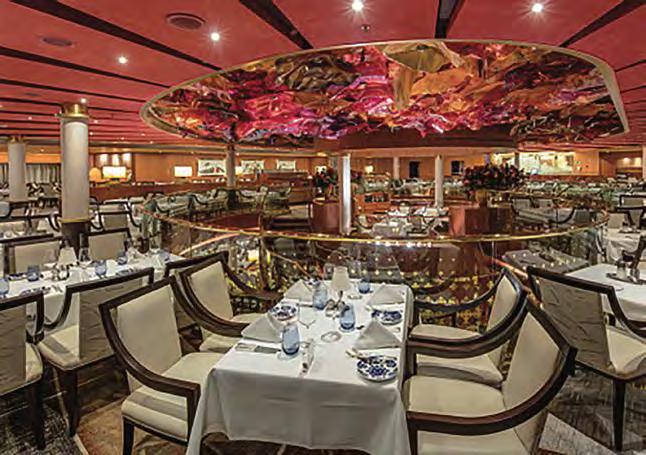
cruising around New Zealand is not a destination that readily springs to mind. But for first timers this is probably the best opportunity to experience what life is really like on board a floating 5-star resort.
Relaxation starts the moment you set foot on board and the sense of space is liberating so you will never feel crowded. Stroll the spacious decks, sink into a voluptuous armchair in one of the many elegant lounges or spend some quiet time in the drawing room with its library books and countless board games. Perhaps a movie appeals or a flutter at the casino, maybe a tutored wine tasting or cooking lesson to entrance one’s palate or just chill out in one of the two swimming pools and three hot tubs. And for the fitness freaks, feel motivated to exercise in the stateof-the-art gymnasium or indulge in the spa with its enticing range of beauty therapies that promises ageless bliss?
There’s something remarkably liberating about cruising, freedom from time restraints plays a big part as does testing yourself each day to see how much food you can eat in any one sitting in any one of six restaurants?
Noordam comes with an army of 200 chefs who prepare 9,000 meals a day. We learn the average weight gain put on by passengers over a 14-day cruise is between four to eight kilos. We ponder whether to eat up and be merry or diet?
“Noordam comes with an army of 200 chefs who prepare 9,000 meals a day. We learn the average weight gain put on by passengers over a 14-day cruise is between four to eight kilos. We ponder whether to eat up and be merry or diet?”
The Lido restaurant on the upper deck is informal and offers a full buffet service morning noon and night plus a deli bar with lighter and healthier meals. In contrast the Dining Room on decks two and three are more formal with the option of open dining or at a time to suit. For a small cover charge Pinnacle, a much smaller silver service grill with its specialty of 15 ounce steaks, Tamarind, an Asian inspired pop-up eatery or Canaletto an experience in Italian suave with Italian sophistication notably famous for its homemade pastas. Whatever your choice you will not be disappointed.
Day two comes all too quickly with our arrival into Tauranga. For most of the afternoon we walk casually around Mount Maunganui


taking in some much needed retail therapy. Later our fellow passengers who visited Rotorua recalled their frustration when the coach driver locked the keys in the bus and they spent two hours standing in the rain until a replacement key was delivered Napier calls, it’s hugely atmospheric with its art deco buildings and its lush orchards and vineyards that contribute to some undeniably fine cuisine. They’re a hospitable lot and as we disembark the Dixie band is belting away, it’s all rather festive and an opportunity to stroll around the city with its gleaming vintage cars and their proud owners bedecked in resplendent clothing from a bygone era.
Good morning Lyttleton. We smile again for the camera as we head off for a 2-hour sightseeing tour of Christchurch. We are amazed by the flamboyancy of the new building’s architecture and the extent of the masses of buildings still under construction from the 2011 earthquake.


Timaru, Port Chalmers is our next port of call and the gateway to Dunedin. Famous for its university students, brewery, Scottish heritage and deceased chocolate factory. The Port itself invites you to explore its architectural heritage, a mixture of charming shops, cafes and hotels
The following morning much to everyone’s disappointment Captain Mark Zoll advises passengers that owing to extreme gale force winds and potential 40 foot swells entering Milford Sound has been cancelled. With the extra day gained, a change of course was ordered to miss the storm but not without 25 foot swells which proved to be a testing time for many of the passengers.
Heading for Tasmania it will be two days before we sight land again. By now we are truly relaxed and long passed being worried about getting cabin fever. Sleep does not come easily for many passengers crossing the Tasman until safely moored at Hobart. We opt for a hop-on-hop-off 90 minute tour of Hobart ended with a relaxing espresso and muffin at
“Whatever you decide food and wine play a big part of daily life and is taken seriously by the ships owners.”
Coffee Roasters immediately across the road.
The next day we arrive at Melbourne. Most go ashore but we catch-up on emails and relax in the library until midday before going on a one-hour walking tour of the city.
Sydney is our final port. Disembarking we reflect on all the memories and the good times, nurture thoughts of hobnobbing with the Morrison’s from NYC, the Williams family from the Gold Coast and the Coleman’s from Wellington, the wonderful activities on board, the excellent meals and vintage wines and the captain and his officers all in neatly pressed black and white uniforms.
Whatever you decide food and wine play a big part of daily life and is taken seriously by the ships owners.
The restaurants cater seamlessly to passengers every whim where
the chefs and sommeliers place a lot of emphasis on the cuisine and wine. Long gone is the eat all you can mentality, in its place quality not quantity.
On the list of other things that the Noordam do well are the daily activities and promotions delivered to your cabin each evening. From 7am to 11pm everything from Tai Chi to Team Trivia to Bingo is covered in detail.
Our final night at sea was notable for two things, a mood of finality, not one of sadness and a realisation that it was soon to end. Land feels odd and for those still to experience cruising would surely look down on us with resentment. But ms Noordam is enjoying a new golden age of cruising and is back in business with luxury cruises that are as popular as ever with packaged holidays bigger and better than the last one!


or relax in
After 14-days at sea if you are wanting to extend your time in Sydney before flying back to New Zealand having access to affordable accommodation is equally important. We stayed at Hyatt Regency Sydney, a top notch hotel centrally located and adjacent to Darling Harbour. It’s within walking distance to some of the best restaurants in Sydney, premier shopping precincts, public transport, galleries and theatres. On offer are some of the best rooms in the city, all-day restaurants, a roof bar with stunning views across Darling Harbour and a 24/7 gym to shed those unwanted kilos. And if you choose to dine out, Muum Maam is one of the best Asian eateries in Sydney. Otherwise talk to Gary Chan at the Concierge Desk who has an intimate knowledge of Sydney’ eating out scene.
Airport transfers: Con-X-ion www.cxn.com.au Cruise World telephone: 0800 500 732 www.cruiseworld.co.nz


Wine and Food Festival (February)
Young winemaker of the year (September)
Cellarbration (October)
Cellar door of the year (October)
Wine Show (October)
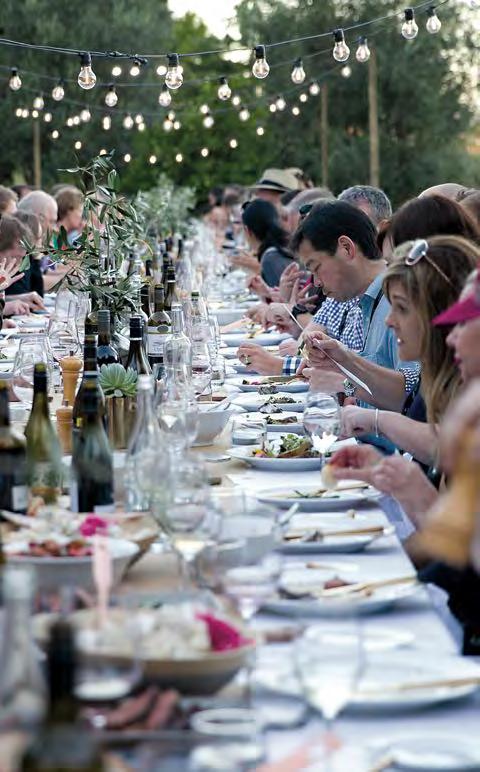
Central Otago Pinot Noir Celebration (January- February)
North Canterbury Wine and Food Festival (Waipara Valley) (March)
Hokitika Wildfoods Festival (March)
Bluff Oysters Food Festival (May)
Hawkes Bay Wine and Food (June)
Wellington on a Plate (August)
Whitianga Scallop Festival (September)
Toast Martinborough (November)
Waiheke Wine and Food Festival (Date unknown)
Craggy Range (November)
Taste of Auckland (November)
Pinot Noir New Zealand Christchurch (February)
Wellington Wine & Food Festival (February)
North Canterbury Wine & Food Festival (March)
Wairarapa Wines Harvest Festival (May)
Ripe Festival Wanaka (March)
These are mostly annual events with dates being as accurate as possible. Please Google for updates as they are posted by organizers of events.






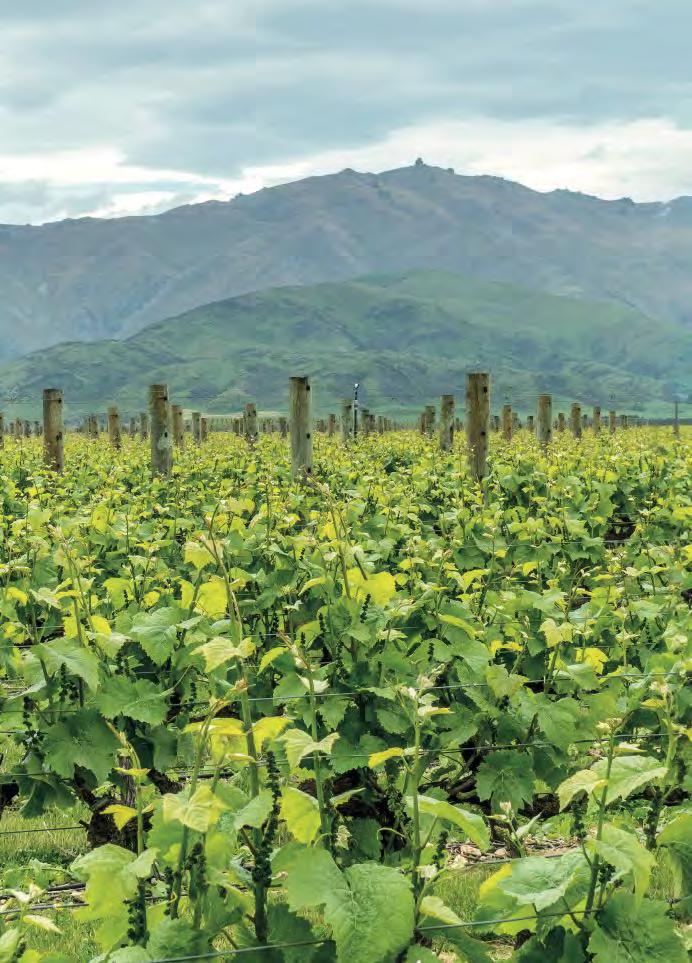
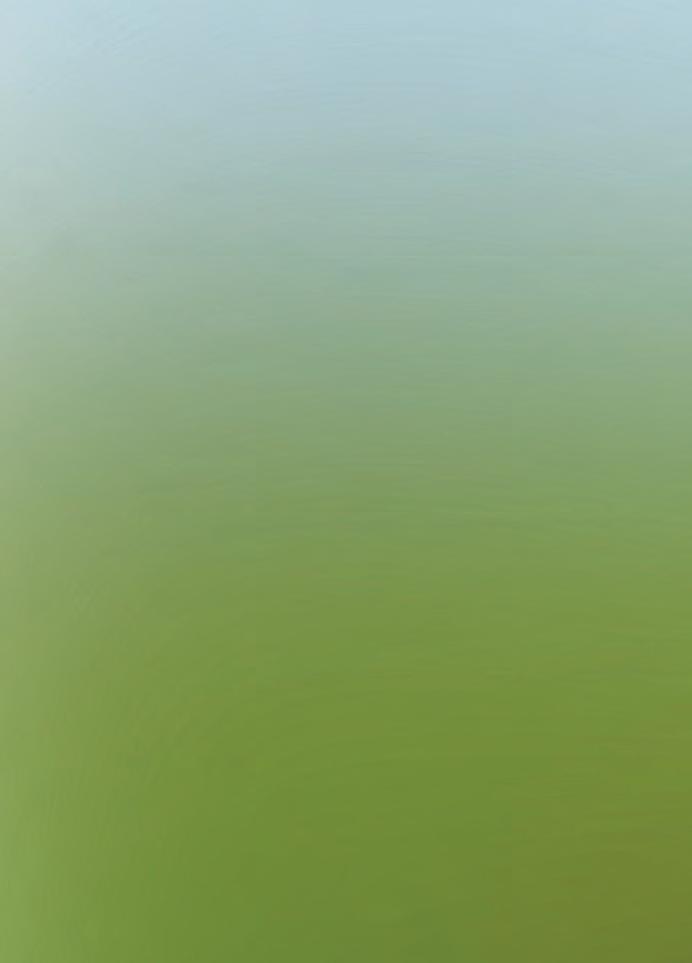

Dennis and Rosamund Knill visit Taupo to explore a property of classic proportions and one of the most frontranking lodges in the world. On the banks of the waikato river.
IN a land not short of competition in terms of luxury accommodation this haven of relaxation is a leisurely threehour drive from Auckland’s frenetic world and a place where Alex van Heeran rebuilt his dream hideaway.
It was in 1984 that Alex and Anne Marie first caught sight of Huka Lodge. Back then it was a modest cluster of canvas huts with a reputation as a sanctuary for wouldbe anglers complete with good food in an open home hosted by Alan and Leila Pye the Irish owners.
Today Huka Lodge has been transformed into a world class retreat that is a favourite haunt for royalty, the rich and famous and other dignitaries. You don’t need a pedigree to stay here just an appreciation of congenial surroundings, warm hospitality and exemplary food and wine.
The first thing you need to know Huka Lodge is not as expensive as you might imagine. Off-season tariffs start at $1125pp and includes cocktails, a 5-course dinner, breakfast and lunch to die for and if you’ve travelling by air transfers to and from Taupo Airport. The second thing you need to know is that as locals we are so fortunate to have such a prestigious get-a-way on our doorstep.
Set on 18 acres the location is majestic. First view is a continuous line of rustic cabins along the banks of the mighty Waikato River offering guest’s country living at its best. The Lodge itself stands solitary dwarfed only by towering trees, manicured gardens, the bucolic bliss of native bush and the constant roar of distant rapids cascading over Huka Falls.
The highest honour bestowed on accommodation is five plus stars, in a few exceptional cases they go higher and Huka Lodge has fallen into this category regularly. All the cabins have super-king size beds, cosy chairs for lounging, a romantic fireplace and an exquisite en-suite bathroom with the added comfort of underfloor heating.
Then there’s the owner’s cottage situated on an elevated and sunny promontory above the river. This stylish and state of the art residence

has a self-contained kitchen, den complete with a wide TV screen, DVD and computer amenities. Four-guest suites are anchored by a central living and dining area that opens out to a large deck and a cantilevered infinity pool and heated spa. Two guest suites face the river, the other two enjoy private courtyards. The living room is the hub of the cottage with a stunning stone fireplace for blazing log fires on a cold winter’s night.
This is a facility that’s ideally suited for company executives wanting that special hideout for an out-oftown meeting or the perfect refuge for those who loathe the trappings of the glamour resort but still want a total escape.
Dining at the Lodge is a sophisticated experience. Executive
chef Paul Frogott’s hallmark seems to be the personal refinements he brings from his years at top notch hotels and restaurants around the globe. It’s from here and his time at Gidleigh Park Hotel and numerous two and three Michelin–Star restaurants in the UK and France that he adopted the idea of traditional French cuisine with a light New Zealand touch. Dinner is about not choosing what to eat but where to eat it. With ever casual air and graciousness our hosts have subtlety inquired to where our preference to dine, the library, trophy room, drawing room, wine cellar, the terrace overlooking the river or alongside one of the outdoor fireplaces - all truly romantic settings.
The table d’hôte menu changes daily and more than lives up to expectations. A typical bill of fare could include chicken soup with tarragon tortellini followed by crayfish with verjuice foam, citrus salt and sautéed cos. Then a delicate goat cheese with beetroot balsamic vinaigrette and herb salad was served before our principal dish of lamb loin with jus of cabernet, potato and mushroom chips and silver beet.
At dessert time we succumb to the chocolate truffle, ice cream and jaffa mousse - magnificently rich but delicately flavoured. The perfect ending is a glass of port and petit fours by the open fire in the drawing room.
There’s is no overt chauvinism shown towards imported wines. The wine list is heavy on local vintages and covers practically every winegrowing region of New Zealand. Our only criticism the
unavailability of at least some of the wines by the glass. Anyway we’re more than happy to settle for a ’18 Villa Maria cellar selection sauvignon blanc, a fine generous wine that was a perfect match for all of the dishes on the menu.
Should boredom set in there’s a myriad of activities ranging from fly fishing, tennis, golf, petanque, horse riding, jet boating, kayaking, bungy jumping and white-water rafting after which relax, reflect and be invigorated with a massage that promises a new lease of life.
Signing the visitor’s book we observe what other guests have recorded with Dame Edna’s comments perhaps the most appropriate as to why Huka Lodge is sought by so many. “In life’s mad race I quite forgot the world held such a tranquil place, where waters glide by glassy green and cars I neither heard nor seen”.








Chef Mark Southon has worked in many fine dining restaurants in New Zealand, Australia and the UK. Here he offers a selection of some of his favourite signature dishes that showcase top-quality New Zealand ingredients.
With sections covering everything from seafood and game, to desserts and vegetables Mark’s recipes capture the distinctive qualities and provenance of the produce he uses. His passion for using fare from the wild and ingredients with special characteristics results in a refreshing approach to achieving the utmost flavour from each dish.
This is a book to inspire home cooks to push the boundaries and serve sensational food. A comprehensive “Basics” section provides tips for making all those little extras that make dishes truly delicious. Complemented by stunning photography and useful plating suggestions, Southon Cooking is the perfect kitchen companion to ensure dining is a memorable occasion.
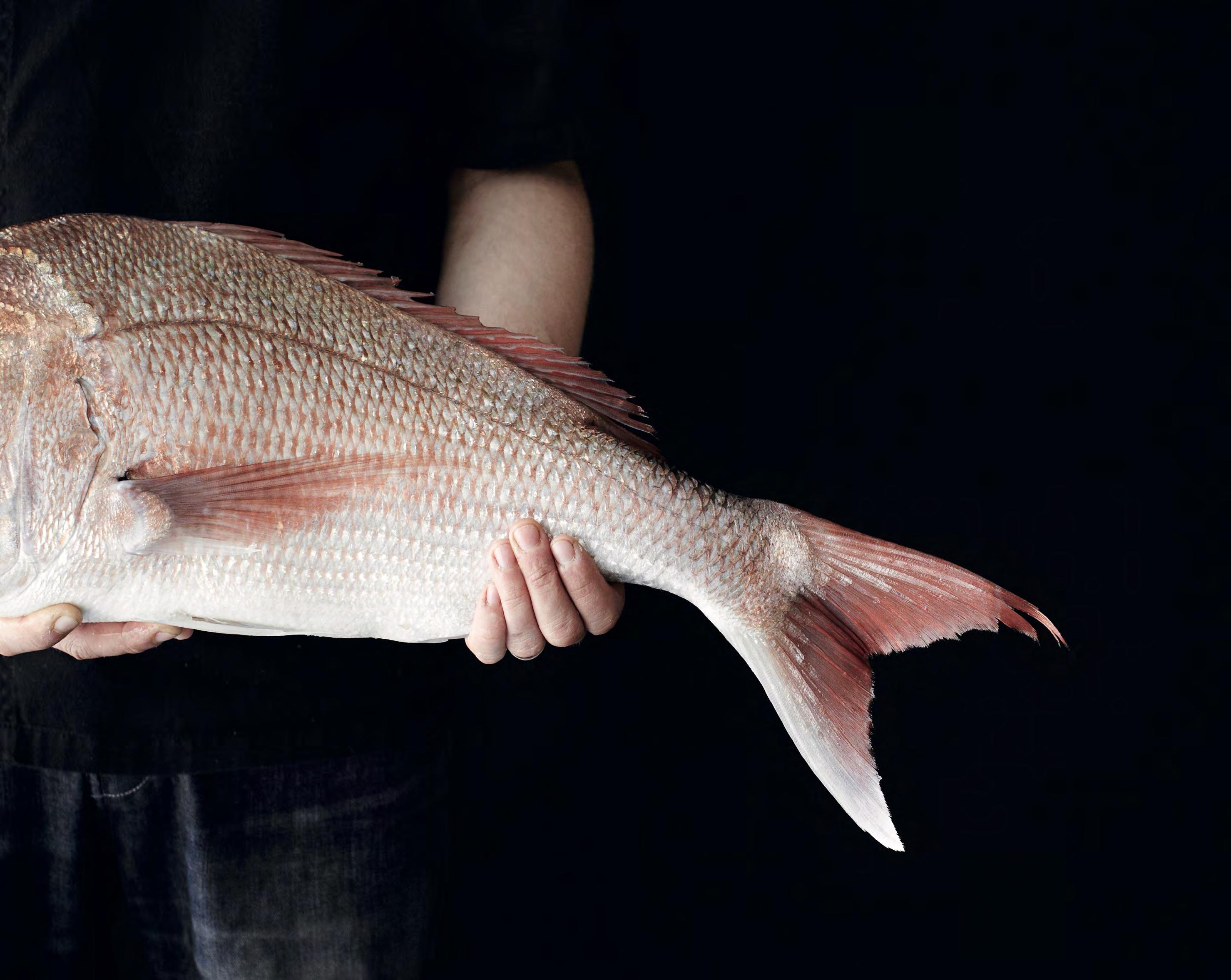
The French Café 9 780473415020 ISBN 978-0-473-41502-0
‘Ultimately Southon Cooking is a book about the New Zealand food we love to eat.’
Simon Wright

ReCIpe S INS p IR ed by f Re SH Ne W Zeala N d p RO d UC e

Manja Wachsmuth

